Just in time for the new COVID outbreak they are telling us to watch the skies for the T. Corona Borealis Super Nova. It can happen anytime between now and mid September.
So much is happening in the news these days it can make your head spin. In all the craziness, GOD is bringing many things that were hidden into the light. He is also giving fresh revelation, and he is showing himself to many who are lost. Especially Jews and Arabs. But, I have no doubt he is revealing himself to others as well.
Hopefully you are beginning to see that the elite have been lying to you all along, about everything. AND YES, indeed there is an organized conspiracy against us, the everyday, working class people. There is a group of well to do, highly intelligent, extremely religious, conspirators working to destroy our faith and trust in the GOD in Heaven who loves us.
They are working very hard to CONTROL every aspect of our lives and every aspect of our BEING! They work under cover through secret organizations, and private counsels to plot and plan how to make you love your slavery, and how to maintain their cover and conceal their intrigues.
The true force behind this Great Conspiracy is a spiritual one. The ancient spirits, the fallen Angels and their progeny. You have been taught to believe that Mythology is only Fairy tales like children’s stories. Made to calm the masses and explain away the unexplainable.
NOT TRUE!!! Mythology is TRUE HISTORY. Written as it was lived out. I understand that to us, who have never witnessed such things it seems to preposterous to believe. However, if you talk to anyone who has experience in the Spiritual Realm or if you are one who has seen what has been done in science labs, or underground bases… you KNOW that these things are not only possible but they are happening EVEN NOW!!!
Yes, there are real shapeshifters, their are real vampires, there are real BIG FOOT creatures, REAL DEMONS, Real spirits who can manifest any way they choose. There are REAL GIANTS!! And there are real people who worship all the pagan gods an goddesses of old, as well as the other otherworldly creatures like trolls, fairies, dragons, etc.
The ruling elite are among those people. They worship all the gods and goddesses of old. Not only that, they know that they are descendants of those very beings. Well, at least some of them are, infact many of them are the progeny of those beings. They can trace their ancestry back, just like the Jews can. Why do you think they have kept all the proof, documentation hidden from us??
Throughout history, the truth has been hidden from the masses. Much of it is in the Vatican Archives, Much of it is in the Smithsonian, and I am sure many other nations have their secret storage.
The very word “secrecy” is repugnant in a free and open society; and we are as a people inherently and historically opposed to secret societies, to secret oaths and to secret proceedings. We decided long ago that the dangers of excessive and unwarranted concealment of pertinent facts far outweighed the dangers which are cited to justify it. Even today, there is little value in opposing the threat of a closed society by imitating its arbitrary restrictions. Even today, there is little value in insuring the survival of our nation if our traditions do not survive with it. And there is very grave danger that an announced need for increased security will be seized upon by those anxious to expand its meaning to the very limits of official censorship and concealment. John F Kennedy SOURCE

YOU only get to see and hear what they want you to. The Fallen Angels and their progeny do not die. They are still here. They have been around for thousands of years. They know everything that has happened and they know much of what will happen. They are the force behind everything that is happening.
If you will stay with me on this post to the end… I think you will come to recognize a lot of what I am saying to you.
As always… I let the contents speak for themselves, mostly. I do make some comments here and there. But, I believe that if the truth is put out there often enough… people will see it for themselves.
spacer
So, hang onto your seats… and let’s get this party started.

This may sound like jingoistic rhetoric but the big one is the Greek flag flying in 1829 after the war of Independence. And nobody really makes a deal about it.
After centuries of subjugation under the Ottomans; only 6 years after Waterloo (1815) when European relations were at their worse and everyone was broke; a decision was made. A huge allied fleet from Britain, France and Russia was established. Army groups from the above alongside revolutionaries from Italy, Serbia and Romania were collected. You even had Haitian and American diplomats arriving on site. Tog ether they and the Greeks decided that a sovereign nation of peoples had the right to decide their destiny and future. They fought for 8 years without any remediation or diplomatic imposition on the Greeks and won – It must be stressed the Greeks did most of the fighting and the other allied groups took their lead.
Main Principles of Democracy in Ancient GreeceHow did their kind of democracy function? People didn’t choose someone to represent their opinion, as we mostly do today. Every male citizen 20 or more years old came to a high hill downtown and had a right to suggest a law or veto one. And yet: women, slaves, and migrants didn’t have any political rights or representation whatsoever. Ancient AthenianIt could come as a surprise, but an ancient Athenian would say that our modern democracy is an oligarchy—the rule of the few.Today we, the citizens, confer our powers onto politicians. In an ancient democracy, every free male citizen could become a city leader or a military commander, write laws, or object to them. SOURCE |
I know you want to consider an Athenian vase or a Spartoi Lembos shield but honestly; Greek culture gave us the first time that modern nations could work together for a common goal without some hidden agenda. If I was Greek I would be shouting from the rooftops about what my country symbolises because of that

What are some of Greece’s unique traditions?
Every region in Greece has a unique tradition.
Let’s try just to mention some of the most generals tho.
- in Greek tradition during Christmas we do not have a christmas tree but a christmas ship. Christmas tree is mostly a German tradition which came in Greece later ( during King Otto era ). Nowadays, christmas boats are mostly seen in Greek islands but still many people and in the mainland keep that tradition alive. It is a symbol of our connection with the seaand it was also our christmas decor because of the sailors who were coming back to their homes for christmas.
Poseidon, the Trident-bearing God of the Sea
Poseidon, the protector of seafarers, was the god of the sea, storms, earthquakes, and, oddly enough, horses and horse breeding. He was the older brother of Zeus and son of Cronus and Rhea. He played a significant role in the war against the Titans. On Crete, he was worshiped in the cave of Amnisos together with Eileithyia, the goddess of childbirth. Inscriptions in Linear B documenting the cult of Poseidon in Minoan Crete as Poseidon-Wanax (Enesidaone) were unearthed at Knossos. Poseidon is the further of the winged horse Pegasus, giant huntsman Orion, Atlas (the first king of Atlantis), merman Triton, and cyclops Polyphemus.

well. ancient greek culture for one influenced the entire world. Aristotle set foundations for logical thinking and was the one who said we should depend on empirical evidence for scientific theories, which is the foundation of modern scientific method.
Zeno of Citium the founder of stoicism which was the philosophy that was the foundation for natural law and natural rights which roman law and much of western law is based on (this is what Cicero of Rome took and implemented with others to Roman culture and the legal system we use today)
much of plato and later neo-platonism was later incorporated into christianity, the trinity, as well as ‘Logos’ which was also an ancient greek philosophical term that was incoporated into christianity.
So yes, ancient greece has influenced modern greece to an extreme extent, as we are followers of democracy, we practise the scientific method, and also practice law based on natural individual rights that were all developed in ancient greece.
Plato’s republic is still one of the most studied book in universities around the world especially the United States and not just modern greek, but much of western society is built around ‘The Republic’ and its basic ideas of a good just society.
So since modern greece is a democratic society and democracy is embedded in our culture now, as well as the scientific method, ideas of natural rights and freedoms, as well as many others I havnt mentioned in order to not have to write an entire essay to answer you, yes, it is very much influenced by ancient greece, just as much of the western world is.
we also still follow hippocrates approach to medicine. And herodotus approach to history. The main subjects of higher learning which are now called trivium and quadrivium which include rhetoric, grammar, logic and the 7 liberal arts were implemented into primary and secondary schools in the Eastern Roman Empire (Byzantine Empire) which was largely a greek influenced society and culture. which most Greeks consider just as big a part of their heritage as ancient Greeks. This is the type of education that has developed into pretty much the basis for most western schools including modern Greece.
So science, art and philosophy wise, modern Greece is not just influenced, but a product of ancient Greece. However these effects have spread far beyond Greece’s borders.
spacer
Whose LAW? What LAW? Which LAW?
REVIVED ROMAN EMPIRE – Maritime Law – You & Your Children – Part 4
Take the LOG from Your Eye – Part 4 – Changing TIMES and LAWS
Are You Having a Mari-Time? – Part 5 – The Law
WHOSE NEW WORLD ORDER IS IT, ANYWAY?
THE UN IS NOT YOUR FRIEND – PART 2 – NOAHIDE LAWS – YOU NEED TO KNOW
THE UN IS NOT YOUR FRIEND – PART 3 – NOAHIDE LAWS Continued
70 Nations to Serve Israel
TEST THE SPIRITS – 1 JOHN 4
spacer
All pagans do a lot of talking about LIBERTY/FREEDOM. Let me tell you something, WITHOUT GOD you have no rights and NO LIBERTY OR FREEDOM. ONLY GOD ALONE can guarantee you FREEDOM. THE MINUTE you allow anyone else, including and especially Satan/Lucifer, to determine your rights and your freedoms… YOU HAVE SURRENDERED THEM ALL and you ARE A SLAVE.
If anyone else or any group, or any government is allowed to decide what rights or freedoms are yours, how do they determine that? Where do they draw the line. They may say one thing today, and change their mind tomorrow.
ALMIGHTY GOD’s LAWS NEVER CHANGE. OUR HEAVENLY FATHER NEVER CHANGES. He created you. Only HE can SAVE you from your bondage to sin and death… You cannot save yourself.
The Writers of the Declaration of Independence KNEW WHAT I AM TELLING YOU IS TRUE.
We hold these truths to be self-evident, that all men are created equal, that they are endowed by their Creator with certain unalienable Rights, that among these are Life, Liberty and the pursuit of Happiness.
There are many today who want to change our Constitution and do away with our Declaration of Independence and surrender the rights of every nation to the greedy, self absorbed elite who run the United Nations. Don’t sell your God Given FREEDOM to anyone at any price.
spacer
Ancient Greece: A brief guide to the history, culture and daily life
In general, scholars agree that we can speak of the first culture and civilization that was specifically Greek at around 1600 BCE. It was a mysterious and prosperous Mycenaean civilization that started on the island of Crete. The first Greek civilization emerged when the pyramids in Egypt were more than 500 years old.
spacer
Olympic Schedule & Results
Paris 2024 Paralympic Games competition schedule
er
Satanic Holidays July – September aligning with the Olympics
| Jul 20-26 | Abduction, ceremonial preparation and holding of sacrificial victims for Grand Climax | Da Meur | oral, anal, vaginal human sacrifice | female (child or adult) |
| Jul 25 | St James Day | Gathering of Herbs | ||
| Jul 27 | Grand CLIMAX (5weeks, 1 day after summer soltice | Da Meur | oral, anal, vaginal human sacrifice |
female (child or adult) |
| Aug 1 | Lammas Day (Sabbat Festival) |
blood | animal and/or human sacrifice | any age (male or female) |
| Aug 1 | Feast of Sun God, Lug, Greeks identified Lugus with the sun god Apollo. Harvest seasons begin | Fire | sacrifice | |
| Aug 3 | Satanic Revels | sexual | oral, anal, vaginal | 7-17 (female) |
| Aug 21 | Festival of – an invocation of the goddess Hecate to protect the harvest. | |||
| Aug 23 | Vulcanalia aka Hephaestus– Roman Festival to Appease and supplicate Vulcan God of Destructive Fire. Vulcan ‘s main Festival | FIRE | sacrifices | |
| Aug 24 | St. Bartholomew’s Day (Great Sabbat and Fire festival) |
large herb gathering | ||
| Aug 25 -Sep 2 | Burning Man marking its 38th year of celebration. ANYTHING GOES/Do as thou Wilt | FIRE sexual |
Sex, Drugs, Pagan idolatry. Sacrificial Offerings | |
| Sep 5- Sep 7 | Marriage to the Beast (Satan) | sexual | sacrifice, dismemberment | infant – 21 (female) |
| Sep 7 | Feast of the Beast marriage of virgins to Satan (sacrifice) | blood | Blood Sacrifice/ human |
Greek Holidays in August
August 15th: The day of the Panagia (Virgin Mary)
This is the second biggest religious holiday after Easter and on the island of Tinos this day is celebrated like on no other. Pilgrims by the thousands come here to crawl on their knees up the steps to the church that holds the holy Icon. But this day is also celebrated in almost every town and village in Greece especially those with a church dedicated to the Panagia (Virgin Mary). That means on the days leading up to it every boat is full and in the islands every hotel is full so keep this in mind if you are traveling these dates. But in general booking a hotel on any island in August is difficult if you don’t do it in advance.
- Agiassosin Lesbos, the second most Holy place in Greece, the pilgrims begin arriving weeks before the 15th and by the 10th of the month the town is alive with ceremony, both religious and social, live music etc. It’s quite a party.
- Petra in Lesbos, similar to Agiassos but not as big.
- Stipsi in Lesbos celebbrates for 9 consecutive days after the 15th. always a good combination.
- Anywhere you go there will be a celebration at one church or another with dancing, food and services. Usually they go on until dawn. The best ones are held in the Monasteries like Profit Elias.
s[acer
  Key dates: 1207 Marco Sanudo a Venetian adventurer conquered Nasso and the nearby islands including Paris 1566 The last Duke of Nasso, Jacopo IV Crispo was cashiered by the Sultan 1645-69 During the War of Candia the Venetians often controlled the Cycladic islands including ParisParis, as the Venetians called Paros, is the second largest island of the Cyclades. In ancient times it was famous for its white marble which was used for many important statues and also for temples (Tempio di Castore e Polluce in Rome). Two large bays on the western (Paroikia) and northern (Naoussa) coasts were important natural harbours.Paroikia  The fortified town and the main tower |

According to excavations on Saliagos, a small island between Paros and Antiparos, Paros has been inhabited since 3200 BC. Mythology states that the Cretan Alkaios was the first king of Paros and built a city on the site of the present capital of Parikia. At the time, Crete traded goods with Egypt, Assyria, and the Balkans.
Paros was an ideal place due to its strategic position (in the center of the Cyclades) and fertile land. The Cretans turned the island into a naval station and named it a Minoa, an honorific title given to Royal Cretan cities. In 1100 BC, the Ionians came to conquer the island. After an initial defeat, they managed to win over the Minoans, destroyed their civilization, and became rulers of the island. Traces of the former civilization are apparent in the Mycenaen Acropolis near Kolimbithres.
Around 1100 BC, when the Dorians attacked the Arcadia region, Arcadians fled to the island. Their leader was Paros, from whom the island took its name. The 8th century BC was a prosperous period in the history of Paros, as the island became a maritime power. Apart from economic development, cultural flourishing also took place at the time. The Parian marble was in high demand, and works by Parian sculptors included the statue of Nike, the Temple of Apollo in Delos, the Asklepiion, the Apteros Nike (in the Louvre Museum), and others.
During ancient times, Paros was famous around the Mediterranean for its high-quality semi-transparent marble, found at the Marathi Quarries. Indicative masterpieces made of Parian marble are the Temple of Zeus at Olympia, the Venus de Milo, the Hermes of Praxiteles, and many others.
Paros was also the birthplace of many ancient poets, such as the lyrical poet Archilochus who was the first to use personal elements instead of heroic ones in his poems.
During the Classical era, the oligarchs of Paros welcomed the Persians on the island and a large part of the army followed the Persian fleet in the campaigns against Greece. After the Persians were defeated in 480 BC, Themistocles forced Paros to become a member of the Athenian Alliance. By the end of the Classical period, Paros had allied with the Macedonians until the death of Alexander the Great. Some of the great discoveries from this era were the ancient pottery workshop in Tholos, with its fascinating works of art, and the ancient cemetery of Parikia.
In the subsequent Roman era, Paros and the rest of the Cyclades constituted a province of the Roman Empire. Economical and cultural growth was stunted, and the island was used as an exile place.
After the fall of the Roman Empire, Paros became part of the Byzantine Empire and its inhabitants converted to Christianity, explaining why numerous churches, chapels, and monasteries were built during those times. The most famous is the Church of Ekatondapiliani in Parikia. The church is believed to have been built after the orders of Saint Helena, the mother of Constantine the Great, and is considered one of the most important Byzantine monuments of Greece.
Between 1207 and 1389, Paros became part of the Duchy of the Aegean, ruled by the Venetian Marco Sanudo. In the 15th century, the Fort of Naoussa was built to protect the island from pirates. Turkish rule succeeded the Venetians until the Greek Revolution of 1821. In addition, during the Russo-Turkish wars (1770 – 1777), the Russian fleet used the bay of Naoussa as a base in the Aegean. After the Independence, the island of Paros, like all the other Cyclades, became part of the modern Greek State.
A major part of the history of Paros is still featured in many parts of the island from ancient to modern times.
spacer
Why Was Greek God Asclepius Linked With Snakes?
Asclepius was the ancient Greek healer who could bring the dead back to life. But why did the Greeks come to associate him with snakes?
Asclepius Learned Healing Powers from a Snake
Given that so many of us are now scared of snakes, the Greek fascination with these creatures might seem a little strange to us today. But it is worth remembering that for ancient Greeks snakes were divine, mysterious and highly knowledgeable beasts, with innate healing abilities. And Asclepius was keen to learn as much as he could from them.
The Cult of Asclepius and Snakes

Ancient Greeks established the Cult of Asclepius, inspired by the stories of this venerated healer. They set up healing temples called Asclepeions. There, healers would perform a series of rituals in order to bring people back to full health. Live, non-venomous snakes roamed freely around the healing temple, bringing their mysterious and enigmatic presence to the surroundings. This particular breed of harmless snake still exists today, and is known as the Aesculapian Snake.
He Could Heal a Deadly Snakebite

In other stories, Asclepius had become so skilled in healing any kind of ailment or illness, that he could even revive those who had suffered from a deadly snakebite. When he fought in the Trojan War, he was able to put his amazing healing abilities to great use. As the story goes, Asclepius was able to heal the famous war hero Philoctetes from a deadly snake bite, allowing him to continue fighting for the Trojan army.
More recently, the Asclepius Snakebite Foundation works closely today with communities to prevent and cure victims of snakebites, and they have based their philosophy around the great healer of ancient Greece. Interestingly, the foundation point out that the cure for a snakebite (and also many other ailments) often comes from snake venom, proving how complex this substance really is!
Athena Gave Asclepius Powerful Venom From Medusa

When he was still learning his trade as a healer, Asclepius received help from a range of sources, including important gods and goddesses. One of the most potent and useful came from Athena, the goddess of war – she gifted Asclepius the blood of the Gorgon Medusa, which was a highly volatile substance. So much so, the blood from the left side of Medusa could cause death, while the blood from the right side could revive the dead. Athena entrusted Asclepius with this potentially hazardous venom, and he mostly used it for good, bringing many mortals back to life. Why is this story relevant? Well, remember Medusa had venomous snakes for hair! Her inclusion in Asclepius’s story further demonstrates the vital role snakes played in his life as a healer, as well as the complex nature of snake venom as both a giver and taker of life. The duality teaching of the Eastern Philosophers and the Fallen Angels.
spacer
Paros (Municipality, Greece)
Πάρος
Last modified: 2015-08-10 by ivan sache
Keywords: paros |
Links: FOTW homepage | search | disclaimer and copyright | write us | mirrors
 |
Flag of Paros – Image by Olivier Touzeau, 16 December 2014
spacer
The coats of arms of Paros
Text: Petros Alexiou
How can one know the history of a place?
Usually through books, narrations and visits to museums or archaeological sites. Nevertheless, there are also other sources that we rarely make much of, although they hide significant riches. At Paros, two such sources are the family names and the coats of arms of the old noble families.
Possibly, the large number and the ubiquitous presence of the family names are the reasons for which we by pass them, without crediting them with the importance they deserve. However, a name can reveal not only the origin and the family history of a person but also aspects of the history of a place. It is indicative that researchers who have studied the surnames of Paros have divided them in five general categories, with three of them practically corresponding to different periods.
A first group comprises the “Greek- old Byzantine” surnames which descend from the time before 1204 – before the fall of Constantinople to the Franks and the Venetian rule. Such are the family names Alisafis, Arkoulis , Agallianos, Paleologos, Argiropoulos and others.
Then, we have the “Franco-Levantine“ surnames dating from the era of the Venetian rule and usually indicating Italian origin: Tsigonias (from cicogna -stork), Armaos (arma-the weapon), Alimprantis (of Lombardian origin), Ragousis (from the old naval Republic of Ragusa).
Then we have the family names of those who fled to Paros after the occupation of Morias and Crete by the Turks. In the families of Cretan or Cretan- Venetian origin we have names like Kritikos, Kandiotis (from Candia, the present day Heraklion), Galanakis, Ritsos Pavlakis, Klironomos, Kavalis (Cavallo-a horse) andalso the names of those from the Peloponnese: Tripolitsiotis, Demetrakopoulos, Moraitis…
Some of these family names fall in the category of the “country and place indicative names” which indicate the placethe name bearer came from, lived and worked: e.g Eginitis, Aivaliotis (Aivali in Asia Minor), Axiotis (from Axia- Naxos) and so on.
Finally, as is also the case in other places, at Paros most surnames originate from someone’s profession or nickname: Milonas, Maounis, Xasouris, Kaparos,(blonde in the Cretan dialect) Galanos, Malamatenios, Akalestos…
The Coats of Arms of Paros
Another related source for the history of Paros is the coats of arms of the island’s old noble families. If we look carefully, we can discern them sculptured, usually in marble, at the lintels of houses, churches even in tombs. More easily we can find images of all of them, made by the painter Dimitris Sifneos. at the historical and folklore Museum of Naousa.
Most of the coats of arms of Paros take us back to the era of the Venetian rule. When the crusaders divided among themselves the Byzantine lands after the fall of Constantinople in 1204, Paros along with some ten other islands went to the Duchy of Naxos, founded in 1207 by the Venetian Marco Sanudo. The Venetians divided the island in small feuds they gave to noble families of the West but also to local noble families.
In 1537 Hayreddin Barbarossa, a notorious pirate but also chief admiral of the Turkish fleet occupied the island, practically putting an end to Venetian rule. However, many Venetian families chose to remain on the island. In time they were assimilated to the Greek population and all of them adopted the Greek Orthodox faith, consequently there is almost no Catholic element at Paros,contrary to what is the case at Tinos, Naxos, Siros and Santorini. In general, the coats of arms of Paros belong to such families,but also to some noble families of Byzantine descent which adopted this social symbol.

Parian coat of arms of the Kondylis family. In the escutheon a left hand holding a pen (kondyli). This coat of arms is found on the grave of +1681 Nikolaos Kondylis in the atrium of Ekatontapyliani.
 |
 |
| Vazaeos (or Vazeos or Vazaeyios or Bazeos or Bazaeos) Franco-Levantine surname related to the noble Venetian family of Baseggio. The crown in the escutcheon corresponds to the title of a duke. |
Kavallis (or Kavalis) One of the Cretan-Venetian families which fled to the villages of Kefalos after the occupation of Crete by the Turks in 1669. An important family (the last Venetian deputy in Crete belonged to it) with a “parlante” coat of arms representing a horse (in Italian cavallo means horse). |
 |
 |
| Kondilis Name of an old, rich and eminent family, most probably of Byzantine origin, whose members had served as consuls of France and Austria at the island. The family is believed to have come to Paros from Athens and to be related with the family of Halkokondilides. Its coat of arms is “parlante” as it bears a pen (kondyli in Greek). |
Marianos Surname of Latin origin, at Antiparos. The coat of arms is probably related to this specific family. A similar surname is met at Naoussa as well, but the connection between the two branches is not clear. |
 |
 |
| Name of the founder of the Duchy of Naxos, Markos Sanoudos (Marco Sanudo), crusader and nephew of the Doge of Venice Enrico Dandolo. The coat of arms of this family is simple. The silver colour alludes to a shield and consequently to a warrior, while the blue to the purity of his character. |
Skordilis Surname of an eminent Byzantine family with significant history in Crete and subsequent presence at several Aegean islands. Most probably its coat of arms is “parlante” as it bears three bulbs of garlic (in Greek “skorda”) -in at least one version- in a green background. |
 |
 |
| Stellas (or Stelas) A Cretan-Venetian family. One of its members was Nikolaos Stellas, a young fighter who died heroically during the Nazi Occupation. In Latin “stella” means “star” something which explains the presence of stars in the family’s coat of arms. Does it? What is the explanation? Why Stars? |
Tsigonias (or Tzigonias or Isigonis) Family of Venetian descent appearing at the Kefalos villages in the 17th century. Its name comes from the Latin word “cicogna” which means “stork”, something which appears in its “parlante” coat of arms. A member of the branch of the Isigonis family was the famous designer of the Mini Cooper sir Alec Issigonis. |
Parian Marble: An incredible ancient chronicle
 August 31, 2018
August 31, 2018
Parian Marble: An incredible ancient chronicle
The Parian Chronicle is a chronology of events, inscribed on a marble stele, covering more than 12 centuries of Ancient Greek history. Focusing a lot on events linked with the city-state of Athens, this chronicle presents us with a timeline from the year 1582 BC to 299 BC. It’s a unique timeline that, surprisingly enough, […]
The Parian Chronicle is a chronology of events, inscribed on a marble stele, covering more than 12 centuries of Ancient Greek history. Focusing a lot on events linked with the city-state of Athens, this chronicle presents us with a timeline from the year 1582 BC to 299 BC.
It’s a unique timeline that, surprisingly enough, few scholars are familiar with. Most people don’t even know that a chronicle like that exists! Let’s see a few important events we all know:
1581 BC : Cecrops becomes king of Athens
The name of the city isn’t yet ‘Athens’ but instead ‘Cecropia’, named after king Cecrops. This obviously provides us with a ‘terminus post quem’ when it comes to the famous story of the contest of Poseidon and Athena! Note that this rivarly between the two gods, as they vied for control of the city of Cecrops and its surrounding territory, Attica, is NOT mentioned in the Parian Marble.
1528 BC : Great flood of Deucalion
There are, literally, dozens of cataclysms recorded by different civilizations all over the globe. A cataclysm is seen by different cultures as an act of divine retribution, sent by God or some other deity to destroy civilization and initiate a rebirth of a new, ‘improved’ breed of humans. The most famous of those flood myths (or deluge myths as they’re also known) is Noah’s Flood as narrated in the Bible, which can be placed about a thousand years earlier than Deucalion’s Flood.

1520 BC : Greeks renamed as ‘Hellenes’.
Hellen (Deucalion’s son) becomes king of Phthiotis. His kingdom is situated in the heart of the Greek peninsula. His people are now named after him, changing from ‘Greeks’ to ‘Hellenes’, giving their name to most other neighboring populations. The Romans however continue to use the ancient name (Graikos) instead of the later ‘Hellen’. Thanks to the Romans, the name ‘Greek’ is used up until today… but only in the western world.
1294 BC : King Minos rules in Crete. King Aegeas rules in Athens
1259 BC : Theseus assumes the throne of Athens
The young hero immediately introduces a constitution and sets the foundations for Democracy. It was obviously on that same year that his father, old king Aegeus, tragically perished.
1256 BC : The Amazons invade Athens!
Theseus at the last moment, manages to stop the Amazons at the Hill of the Muses and defeats them.
1218 BC : War of Troy starts
1209 BC : Troy is conquered

907 BC : Homer appears
895 BC : Aegina mints silver coins.
From this date on, we have sound archaeological and historical evidence and we can be almost certain about the events recorded on the Parian Marble.
From this year on, all dates, events and names of people are spot on! It’s very tempting to assume that all previous dates and events are correct too. I wish…

spacer
Greek Island Of Paros: The Mythology Of The Place

spacer
Paros, an enchanting island in the Cyclades, is not only known for its beautiful landscapes and pristine beaches but also for its rich tapestry of myths and legends. This blog post explores the mythology of Paros, delving into the stories of gods, heroes, and ancient origins that make this island a fascinating destination for mythology enthusiasts and history buffs alike.
Mythological Significance of Paros
 Ares: The God of War
Ares: The God of War
Paros has a strong connection to Ares, the god of war. Ancient texts mention that Ares was particularly worshipped on the island, and there was a significant sanctuary dedicated to him. This association underscores the island’s importance in ancient Greek religious practices.
Alcaeus of Paros
Alcaeus, a semi-mythical warrior, is said to have established a colony on Paros. His legacy is embedded in the island’s history, contributing to the rich mythological tapestry that characterizes Paros.
The Mythological Origins of the Cyclades
According to Greek mythology, the Cyclades islands were originally nymphs turned into islands by Poseidon, the god of the sea, after they angered him. Paros, as one of these islands, shares in this mythological origin, adding a layer of divine intrigue to its natural beauty.
 Historical Sites Connected to Mythology
Historical Sites Connected to Mythology
The Ancient Marble Quarries
Paros is famous for its high-quality marble, known as “Parian marble,” which was used in many famous sculptures. The ancient marble quarries, located near Marathi, are a testament to the island’s historical significance and its contributions to art and architecture in the ancient world.
Panagia Ekatontapiliani
The Church of 100 Doors, or Panagia Ekatontapiliani, is one of the oldest and most important Christian monuments in Greece. This early Christian basilica, dating back to the 4th century, showcases the island’s long-standing religious significance.
Modern Attractions with Mythological Roots
Traditional Villages
Villages like Naoussa, Parikia, and Lefkes are steeped in history and myth. These villages reflect the traditional Cycladic architecture and offer a glimpse into the island’s past, where mythology and daily life were deeply intertwined.
Archaeological Museum of Paros
The Archaeological Museum of Paros houses numerous artifacts that provide insights into the island’s rich mythological and historical past. From ancient sculptures to relics of everyday life, the museum is a treasure trove for anyone interested in the ancient world.
 Top Archaeological Sites in Paros
Top Archaeological Sites in Paros
The Delion Sanctuary
The Delion Sanctuary is dedicated to Apollo and Artemis, located near the ancient city of Paros. This site offers a fascinating glimpse into the religious practices and architectural styles of ancient Greece, with remains of temples and altars.
The Asklepieion
The Asklepieion of Paros was a healing temple dedicated to Asclepius, the god of medicine. Situated near Parikia, it served as a place where ancient Greeks sought cures for their ailments, combining religious rites with early medical practices.
Conclusion
Paros is an island where myth and history blend seamlessly, offering visitors a unique opportunity to explore ancient legends and their lasting impact on culture and heritage. Whether you are drawn to the stories of gods like Ares, the legacy of Alcaeus, or the mythological origins of the Cyclades, Paros provides a captivating journey through the annals of Greek mythology.
spacer
spacer
We have already covered the 2024 Olympics in Paris. There should be enough in the posts below to demonstrate how disgusting and lascivious the city of Paris is and why. If you have not visited these posts check them out.
COCK ‘N BULL Paris Olympics
2024 Olympics – Paris – WHAT YOU NEED TO KNOW
spacer
Whether its Paris, France or Paros, Greece, the root is the same, Pari/Parika
spacerspacer
Parī
 Parī, flying, with cup and wine flask. Miniature by Şahkulu. Freer Gallery of Art
|
|
| Grouping | Mythical creature |
|---|---|
| Folklore | Pre-Islamic Persian folklore, Islamic folklore |
| Country | Muslim world |

Parī is a supernatural entity originating from Persian tales and distributed into wider Asian folklore
pari/peri (n.)
spacer

Marathi – Paros (Greece)
Marathi. Marathi was once a very important village on the Greek island of Paros. From this region came the famous Parian white marble, once used to build important historic buildings and statues. The marble quarries existed before the year 3000 BC. In the 19th century, Greek and foreign companies located here to mine the marble. Why is the marble of Paros so special? Because it is much more transparent than marble from other areas, giving it a more pleasing appearance. Famous works made of Parian marble include the Venus of Milos (Louvre) and Nike of Samothrace (Louvre). Just outside Marathi there is an exhibition of marble art pieces, created by Greek artists. Marathi is located four kilometers (2.5 mi) east of Parikia, in the village live today about one hundred people.
Text: Yorgos and Wendy Nikolidakis – Edited by Katrina Butzer
Photo Gallery Marathi – Photos of Marathi

Paros: Where on the map is Marathi located?

Marathi language
| Marathi is tied to the Maratha empire which waxed and waned over centuries, at its height it covered more than half of then undivided India stretching from the South all the way to Afghanistan. Hence you’ll see Marathi have all sorts of influences from the breadth of the country. While you mention Baba being Persian, the counterpart “Aai”, is actually a Dravidian word, with Tamil origins, also Akka for sister. Source |
Maratha
Maranatha
- Greek alphabet: The uppercase and lowercase letters of the Greek alphabet
- Poseidon’s trident: The three-pronged fork of Poseidon’s trident represents his power over the sea and his weapon
- Caduceus:The short staff of Hermes in Greek mythology, entwined by two serpents and sometimes with wings
- Evil eye: A curse from Greek culture that is believed to be sent by someone who is jealous of you
- Dolphin: Greece’s national animal,associated with the god Delphinus, and symbolizing hope, compassion, and helping others
- National emblem: A blue crest with a white cross surrounded by two laurel branches
- Olive branch: A symbol of peace and friendship dating back to ancient Greek mythology
- Pomegranate: A symbol of fertility and abundance, and the custom of breaking pomegranates in a new home for good luckdates back to ancient Greece
spacer
As we all know, or should by now, SYMBOLISM is a very important tool in the SPIRIT REALM. Both for Good and for EVIL. If you know how to read and understand Symbols, you can learn a lot about a person, an organization, a group or a nation just by viewing the symbols that they employ.
This next portion of the post should help you to know more about the Greeks and how much they have influenced our world, and not for the good. Though they want you to believe that everything they have presented to the world is for good. Don’t you believe it. Know who they worship and you will know that they are not on the side of good. Those who are not of Our Heavenly Father, cannot discern good from evil. They cannot recognize TRUTH.
spacer
Coat of arms of Greece
From Wikipedia, the free encyclopedia
| Coat of arms of Greece | |
|---|---|
 |
|
| Versions | |
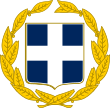 Military version, used by the Greek military and security services and on the presidential standard
|
|
| Armiger | Hellenic Republic |
| Adopted | 7 June 1975 |
| Shield | Azure, a Greek Cross throughout Argent |
| Other elements | Two laurel branches |
The proper heraldic description of the coat of arms is: Azure, a cross Argent. The Law regulating the coat of arms does not specify a tincture for the laurel branches, implying proper (or vert, i.e. green). Official usage portrays the laurel branches as monochrome blue, while a version with the branches in gold is used by the military and on the presidential standard. Since standardisation in 2010, the Government of Greece has used a stylised version of the coat of arms as a government logo, again in monochrome.
In periods of monarchy, the shield was topped by a royal crown and surrounded by elaborate ornamentation expressive of royal authority, including male figures as supporters, the Order of the Redeemer, a mantle and pavilion, and the royal motto. The shield was also sometimes charged with the dynastic arms of House of Wittelsbach under Otto of Greece, and by those of the House of Glücksburg after his exile. Other designs adopted prior to 1832 made heavy use of ancient Greek imagery, such as Athena and her owl, as well as other popular revolutionary symbols such as the Phoenix rising from its ashes, symbolising the rebirth of Greece as an independent state.
History
Non-heraldic designs
The political thinker and revolutionary Rigas Feraios was the first to propose a national emblem for Greece, including a hand-drawing rendition of it in his hand-written New Political Constitution of 1797. Rigas’ proposal was composed of a club of Heracles, with the words Liberty – Equality – Fraternity superimposed on it, and three crosses topping it. In his Map of Greece of 1796–1797, Rigas explains that the club stands for the power of Greece, but its use was not limited to ethnic Greeks and could also be used by any of the other Balkan peoples he envisaged would make up his multi-ethnic Hellenic Republic. In his selection of this device, however, he was directly influenced by the Jacobin radicalism of the French Revolution, which utilised the device of the club of Heracles as a symbol of democratic power. The national colours he proposed were red, white, and black, symbolising self-determination, purity, and sacrifice respectively. The club, sewn onto a white cockade, would be the identifying mark by which “free democrats and equal brothers” would recognise each other. This design was never officially adopted.

club of Heracles, with the words Liberty – Equality – Fraternity
The first official Greek national emblem was described in the Provisional Constitution adopted by the First National Assembly at Epidaurus on 1 January 1822 and was established by decree on 15 March of the same year. The national emblem was described as a simple cockade of white and blue. These colours were chosen as the national colours over more “revolutionary” choices such as black and red, popular in Greece ever since Rigas had proposed them, so as to disassociate the government and the revolution from any perceived links to radical movements in the eyes of the conservative European royal courts.
Since its establishment, the emblem has undergone many changes in shape and in design, mainly due to changes of regime. Apart from the cockade, the Provisional Administration of Greece used a seal depicting the goddess Athena and her symbol, the Owl of Athena, encircled by the words “Provisional Administration of Greece”. During the governorate of Ioannis Kapodistrias (1827–1831), a new seal based on the phoenix, the symbol of rebirth, was created. The words “Hellenic State”, accompanied with the date “1821” (the year the Greek War of Independence began) in Greek numerals, surrounded it.
This seal gave Greece’s first currency, the Phoenix, its name. The phoenix was also used as a symbol by later Greek non-monarchical governments, including the Second Hellenic Republic (1924–1935) and the junta-proclaimed republic of 1973–1974.

The current coat of arms of Greece derives from the Greek national flag, which was adopted in March 1822. Theories published retrospectively in Greece try to justify this use by making a connection to Byzantine flags and insignia. The 1934 edition of the Great Greek Encyclopedia explains that “the current national emblem of Greece shares this with the last emblem of Medieval [Greece], that it is made up of a cross dividing the emblem into four quarters. The difference is that the emblem of the Imperial house of the Palaiologoi also had a capital B in each of the quarters”. This design is well attested in Byzantine and Western sources during the 14th and 15th centuries, but as the Byzantines entirely lacked the Western tradition of “national” or family heraldic designs as coats of arms, this design was only used in flags.
Wittelsbach dynasty
The introduction of the blue shield with the white cross as the heraldic device to represent Greece occurred on 26 February [O.S. 7 January] 1833, when the regency council which was governing Greece on behalf of its first king, Otto, announced the official design for the coat of arms. Approved by Prime Minister Josef Ludwig von Armansperg, it detailed the entire heraldic achievement and described, in Greek and German, its constituent parts. The lesser arms are described as an “equidistant azure escutcheon, pointed towards the middle of its lower side, and

containing the Greek cross, argent, bearing at its centre an inescutcheon with the lozenges of the Royal House of Bavaria.” The shade of blue is specified as light blue (German: hellblau). The escutcheon itself was supported by two crowned lions rampant and surmounted by the royal crown. The entire composition was contained within a mantle and pavilion, purple on the outside and ermine on the inside, topped again with the royal crown. This emblem was discarded following the 23 October 1862 Revolution and Otto’s subsequent exile. Despite this fact, however, the blue shield with the white cross remained the basis upon which all subsequent coats of arms were based, including the current arms of theThird Hellenic Republic. The white and blue cockade of the revolutionary period was reinstated in March 1833, this time blue on the outside and white on the inside, so that the blue centre was equal to two thirds of the diameter of the cockade. This design, described both as a ‘national emblem’ (ἐθνόσημον) and a ‘cockade’ (κοκάρδα) in Greek and as the ‘national cockade’ (National-Kokarde) in German, was to be worn on caps by uniformed military and civilian personnel as well as on the hats of private citizens that wished to display their national pride.
Glücksburg dynasty and Second Republic
Following Otto’s deposition in 1862, the 17-year old Prince William of Denmark was chosen in 1863 as Greece’s new king. The coat of arms was suitably altered by the Royal Decree of 9 November 1863. The text of the decree was almost identical to that of 1833, with minor additions and removals to accommodate Greece’s new royal house, the House of Glücksburg. The escutcheon remained the same, but the dynastic arms of the Glücksburg family, including the three lions of the arms of Denmark proper, the two lions of Schleswig, the nettle leaf of Holstein, the horse head of Lauenburg, the two red bars of the House of Oldenburg and the yellow cross of Delmenhorst, were added in an inescutcheon at the centre of the cross when the coat of arms was used to represent members of the Greek royal family. The shield remained surmounted by the royal crown but the supporters were changed to figures of Heracles, similar to the ‘wild men‘ of the coat of arms of Denmark. This gave rise to the use of the term “Ἡρακλεῖς τοῦ Στέμματος” (“Heracleses of the Crown”) as a derogatory term for Greek monarchists. The Order of the Redeemer was also added, while the new royal motto, “Ἰσχύς μου ἡ ἀγάπη τοῦ λαοῦ” (“The people’s love is my strength”), was also introduced in gold lettering on an azure band.
1924–1935
When Greece became a republic in 1924, all ornamentation was discarded and a simple escutcheon adopted as the coat of arms. During the short-lived dictatorship
-
1925–26 version of the arms under the Pangalos dictatorship
of Theodoros Pangalos in 1925–26, four symbols were added to the national emblem in the four quarters created by the cross: the head of Athena, symbolising the ancient Greek period; a helmet and spear, symbolising the Macedonian period; a double-headed eagle, symbolising the Byzantine period; and a phoenix rising from its ashes, symbolising the modern Greek period. A wreath of oak leaves on the right, and of laurel leaves on the left, surrounded
the emblem, symbolising power and glory, respectively. This particular emblem was criticised for being inappropriate and violating heraldic rules, before being again replaced by the simple shield following the fall of Pangalos and his dictatorship. Until the abolition of the republic in 1935, a phoenix was often added in the centre of the cross as a symbol of Greek republicanism.
Following the return of the monarchy in 1935, the original smaller version of the coat of arms of Denmark representing the royal family was supplanted by the greater coat of arms of Denmark of 1819–1903, and consequently also in 1863 when the Danish prince William accepted the Greek throne as King George I. This greater arms included all the former elements, as well as the three crowns of the former Kalmar Union, the stockfish of Iceland, the ram of Faroe Islands, the polar bear of Greenland, the lion and hearts of the King of the Goths, the wyvern of the King of the Wends, the swan with a crown of Stormarn, and the knight on horseback of Dithmarschen.
During the 1941–1944 Axis occupation of Greece, the Greek puppet government used the republican escutcheon, “crowned with the depiction of the mythological Phoenix bird rising from its ashes, surrounded in between its wings by a contour of rays”.
Junta-proclaimed republic (1973–1974)
In 1973, the then-ruling military junta abolished the monarchy, which was confirmed by a subsequent referendum. The constituent act that abolished the monarchy bore just the inscription “Government Gazette of the Hellenic Republic” (June 1, GG Issue 118 A). The following two issues (119 and 120, June 1 and 2 respectively), featured a phoenix rising from its ashes, with the soldier’s silhouette clearly erased, in contrast with the “Phoenix and Soldier” design used widely before in coins, stamps, books, matchboxes and propaganda posters. Between June 5 and July 5 a new, rounded version of the phoenix appeared on Government Gazette issues, which was subsequently featured on ID cards, passports and other miscellaneous documents, such as lottery tickets, even after the finalization of the form of the phoenix. A rounded version was also adopted in new coinage. On July 5, the design of the phoenix was finalised. It was subsequently used on military uniforms, passports and other official uses, while seals and material adhering to previous designs were also considered valid.
Ioannides’ regime did not abolish it; as such it was used till August 1, 1974, when the Karamanlis administration issued a GGI without it. No coat of arms was used whereas possible till June 7, 1975, when the current coat of arms was introduced; however, coins bearing the phoenix continued being legal tender for a period.
|
Semi-official “Phoenix and Soldier” emblem, as it appeared on currency from 1971 to 1973
|
Seal with the first version of the phoenix emblem
|
The second version of the phoenix emblem (June 5 – July 5, 1973)
|
-
-
Third version of the phoenix emblem (July 5, 1973 – June 7, 1975)
-
Great Seal of the State with the third version of the phoenix emblem
-
After the collapse of the military regime in 1974, the new government decided to hold another referendum regarding the form of government as acts of the junta were considered to be illegal. The 1974 referendum resulted in the republican form of government being maintained. This confirmed the abolition of the royal coats of arms, but the achievement remains in use by the current pretenders of the Greek royal family.
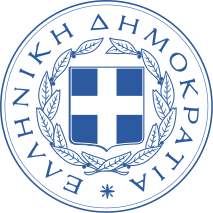
The current emblem is defined by Law 48/1975. The blue shield with the white cross was restored, and the proportions of the escutcheon specified as 1⁄8 longer than its width. The shield is surrounded entirely by two branches of laurel; their colour is not specified but in practice they are almost universally shown as monochromatic. The coat of arms was designed in 1974 by Greek artist Kostas Grammatopoulos. The government uses a stylised version of the coat of arms as a government logo. The design was implemented beginning in 2010 as a means of standardising the branding of the various Greek government ministries. It specified the design and colour of the national emblem when used as a logo, and designated FF Meta as the official typeface for use across all media to represent the Government of Greece. Instead of showing the blue parts of the shield as solid colour, the government logo utilises heraldic hatching, with horizontal lines signifying azure (blue).
The Great Seal of the State (Μεγάλη του Κράτους Σφραγίς) is Greece’s official Great Seal, used to confirm official documents. The current design was set out in the same law that specified the coat of arms in 1975; it is made up of the coat of arms, surrounded by the words Hellenic Republic (Ελληνική Δημοκρατία) in capital letters, contained within a circle 60 millimetres (2.4 in) in diameter. Previous Great Seals were also specified by previous decrees specifying the older coats of arms in 1833 and 1863.
| Hellenic (adj.) |
| WHAT IS HELLENISM? It may surprise you that Greeks don’t call themselves “Greek”. Instead Greeks refer to themselves as “Έλληνες”— Hellenes. The word “Greek” comes from the Latin “Graeci”, and through Roman influence has become the common root of the word for Greek people and culture in most languages. In English, however, both “Greek” and “Hellenic” are used. When most English speakers say “Greek” today, they mean the people and culture associated with the modern nation-state of Greece.“Hellenism”, however, is something bigger. From ancient times, the language, culture, and values of the Hellenes has significantly impacted the world. Throughout history non-Hellenic people have adopted and assimilated the values and aesthetics of the Hellenes. Through this contact, the culture of the Hellenes has not only transformed other cultures, but has been transformed itself. This relationship is Hellenism. In fact, an openness to new ideas and embracing beauty and truth wherever you find it are fundamental features of Hellenism. In short, Hellenism is rooted in the history of the Greek people, but it is bigger than Greek culture. It is part of humanity’s shared heritage.
The National Hellenic Museum seeks to share the story of Greek Americans – as chapters that continue from the ancient story of Hellenism. These are stories of transforming and being transformed. These are stories of ancient values and modern innovations. Hellenism is alive today in each of us — whether we have Greek ancestors or not. |
| hell (n.) |
spacer
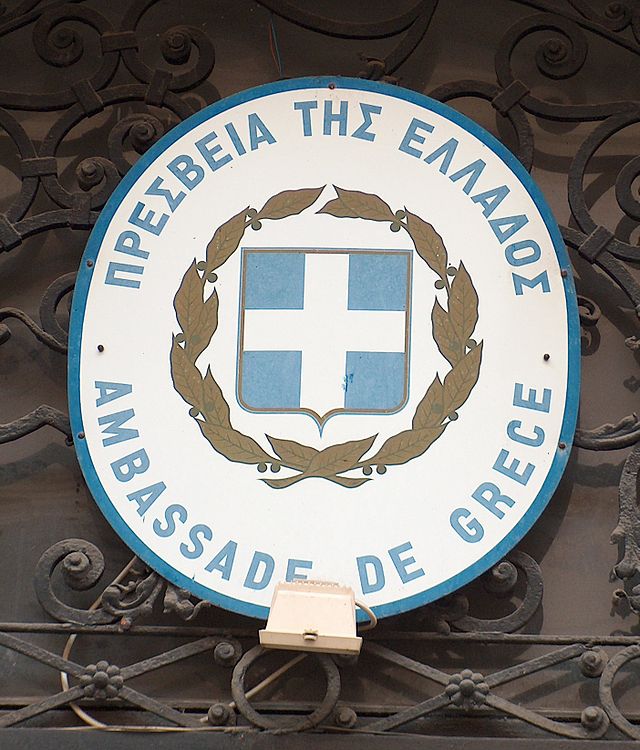

The colours used to render the coat of arms are inconsistent. The original regulation does not specify a colour for the branches of laurel surrounding the escutcheon, implying that they should be green, or proper tincture. In effect, however, usage varies greatly. The 2003 version of the Civil Service Communications Regulations provide a scalable vector graphic file of the coat of arms in black, without specifying any colours. Other government guidelines, such as that used in the Publicity Guidelines for public works (as part of the European Globalisation Adjustment Fund), are heraldically inconsistent and require the laurel branches to be green (if not black-and-white), but the blue of the escutcheon is shown as horizontal hatching instead of solid colour. Similar guidelines were issued by the Independent Authority for Public Revenue as late as 2017. The most common usage is that of the laurel branches in monochrome. The general government guidelines which regulate the government logo are monochromatic, and so the laurel branches are not coloured.
The official shade of blue that the coat of arms should be rendered in is also not specified. Historically, the shade has varied from light blue under King Otto to darker shades in later years. Differing shades of blue were also used by different departments of the Government of Greece, until the guidelines regulating the government logo were implemented in 2010. These specified the various colour codes to be used:
spacer
spacer
cockade (n.)
spacer
cockade
|
Name by language
|
|
|
english
|
cockade
|
|
korean
|
Cockade, Mouth
|
|
Japanese
|
円形章
|
1. outline
 |
|
The tricolor cockade of the French Revolution
|
Cockades were widely used in the 18th and 19th centuries as a mark indicating the wearer’s rank, party affiliation, or nationality in color and shape, and were often used in military uniforms.
It is mostly used as a hat decoration, but it is also attached to lapels, shoulders, chest, arms, sleeves, etc., or just like a hairpin.
2. origin
 |
|
White cockades of the Bourbons[3]
|
 |
 |
|
Hanoverian black cockades[5]
|
As one of the important factors that caused the spread of cockades, cockades are also closely related to modern European military culture. Basically, the modern rules of engagement were derived from the European military culture of this period and codified in the Hague Convention. Looking briefly at the basic gist of the rules of engagement, in order for an armed organization to be recognized for the right to engage in warfare, whether it is the regular army, the militia, or the volunteer army, it requires that it have a clear chain of command, wear a uniform or mark that identifies its affiliation, and openly carry weapons. .[6]
Of course, in the case of militias or volunteers who have invoked the right to resist in an emergency situation under enemy invasion, there are many cases where it is practically impossible to properly unify uniforms, so armbands, hoods, or cockades are also acceptable as identifiable marks of affiliation. .
At that time, there was no such thing as synthetic fabric like now, and industrialization had not even begun except in Britain, so the issue of providing uniforms to all combatants was a rather tricky problem. In that sense, the cockade was spotlighted as a useful marker not only in the revolutionary uprising but also in the regular army and was widely used.
3. era of revolution
From the end of the 18th century, movements to form modern nation-states appeared throughout Europe, starting with the American Revolution and the French Revolution , which served as an opportunity for cockade to spread widely.
3.1. american revolution
What is noteworthy is that before the Declaration of Independence was resolved, even before 1777-8, there were many people who had the perception that the
 |
 |
|
The Continental Army’s ‘Alliance cockade’ during the Revolutionary War
|
|
3.2. French Revolution and after
 |
 |
|
Symbols of the French Revolution: the Phrygian cap and the tricolor cockade
|
|
During the Napoleonic Wars, cylindrical shako hats were introduced as military hats, gradually replacing the previous bicorne or triangular hats. The cockade was usually attached to the uppermost part of the front of the shako. In addition to France, other countries such as Prussia, Austria, and Russia also made and attached cockades in the colors of their respective national flags to their military caps.[10]
The Napoleonic Wars finally ended with the restoration of the Bourbon monarchy and the restoration of the old system represented by the empty system, but it served as an opportunity for the movement to build a modern nation-state to spread throughout Europe. The cockade was considered and used as a symbol of such a nation-state. After the middle of the 19th century, independent armies of the subjugated peoples in Poland, Hungary, and Latin America used cockade as the color scheme for the national flag.[11]
 |
|
Cockades of constituent states of the German Empire
|

You can say something about cocaine, but[14] The Korean Empire has also adopted something similar. The pattern is, of course, the red-blue Taegeuk pattern. The photo above is Park Gi-jun’s wedding dress and bicorne hat. In the case of the relationship with the roundel , which will be described later, the roundel of the Republic of Korea Air Force is a red and blue Taegeuk pattern. Since the pattern originated from the Taegeukgi , and the Republic of Korea adopted the Taegeukgi as it is, Roundell imitated the Taegeukgi, so it can be seen that there is not a lot of relationship.
4. conjugation in roundel
 |
 |
|
|
World War I and modern French Air Force national emblems. The color of the three-color cockade sentence is used as it is.
|
||
spacer
SPIRALS AND THE GREEKS
The mystery of the Phaistos Disc has been “solved by 99 percent” Gareth Owens, a linguist, archaeologist, and coordinator of the program Erasmus of Crete Technological Institute announced recently.
Owens has devoted thirty years to trying to solve the puzzle. The Minoan goddess of love, Astarte, who is linked to the Eastern goddess Ashtart, is the key figure that unlocks the mystery of the Phaistos Disc, Owens argues.
The Phaistos Disc is a disk of fired clay from the Minoan palace of Phaistos on the island of Crete, possibly dating to the middle or late Minoan Bronze Age (second millennium B.C.).
Phaistos Disc: one of archaeology’s greatest mysteries
The disk is about 15 cm (5.9 in) in diameter and covered on both sides with a spiral of stamped symbols.
The language imprinted on the face of the mysterious disk has never been fully decoded, and its symbols are part of no known alphabet either ancient or modern.
Others are similar to hieroglyphs found in ancient Anatolian sites.
Although the vast majority of scholars believe that the Phaistos Disc is authentic, a few archaeologists are unconvinced of its authenticity.
This unique object is now on display at the Archaeological Museum of Heraklion.
Is the goddess of love the key to decoding the disk?
He, along with his team, is using evidence and strategies from linguistics and history to decode the mysterious disc.
Owens says: “We are reading the Phaistos disc with the vocal values of Linear B and with the help of comparative linguistics, i.e. comparing with other relative languages from the Indo-European language family. Reading something, however, does not mean understanding.”
According to his data, the disc is a religious text to a “pregnant goddess” that takes shape in the face of Astarte, the goddess of love.
The scholar adds that he suspects that “the Phaistos Disc is a hymn before Astarte, the goddess of love. Words such as those mentioned on the disc have been found on Minoan offerings.”
“As with today’s offerings, people pray when they are troubled, because of health problems or personal reasons,” he says. “Man doesn’t change, after all.”
The archaeologist says he believes that one side of the Phaistos Disc is actually dedicated to a pregnant mother goddess while the other is dedicated to the Minoan goddess Astarte.
On the importance of the figure, Owens noted that Minoan Astarte was the goddess of love, war, and the mountains and that her origin lies in the east. The goddess’s roots are “from ancient Mesopotamia, located in today’s Turkey; Astarte went to Cyprus and became Venus,” he explained.
spacer
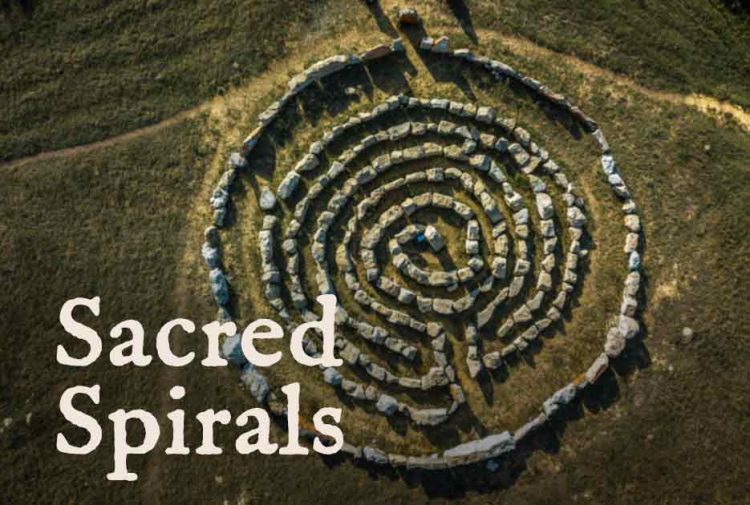
spacer
I warn you before you proceed that the following article is chuck full of pagan beliefs and teachings. Remember, the devil always starts with a little truth, which he perverts in order to direct you away from TRUTH and the TRUE CREATOR GOD.
spacer
Sacred Spiral: Meaning of the Ancient Symbol of the Goddess
To understand the meaning of the ancient spiral symbol, let’s look first at its etymology (word origin): Spiral comes from Ancient Greek σπείρα (speíra) meaning “wreath, coil, twist”.¹ In Medieval Latin the word spiralis means: “winding around a fixed center, coiling”.²
The spiral is not just a swirly symbol, it is one of the most frequent shapes in everything that is related to life and growth, evolution and expansion. A large number of plants and animals develop in a series of patterns directly related to the spiral.
spacer
 |
As Above,
So Below. |
 |
From the shape of the DNA known as the “double helix” to seashells, pinecones and the fingerprint, Mother Nature is a great lover of spirals. In fact, “helix” is simply the Greek word for “spiral-shaped”. The spiral of life symbol is one of the most widespread forms in nature: hurricanes, embryos, galaxies, whirlpools, animal horns… we are surrounded by spirals at every level — “as above, so below”.

Sacred Spirals
What do spirals represent?
Spirals represent the concept of rotation around a fixed point while increasing its distance from that point. The spiritual meaning of the spiral is interconnected and stemming from the source of all creation.
A spiral has been a sacred symbol for a long time and it symbolizes development, extension, rotation and progress. The spiral shows us the cyclical nature of evolution where the rhythms are repeated. It evokes an archetypal path of growth and transformation, both physically and spiritually.
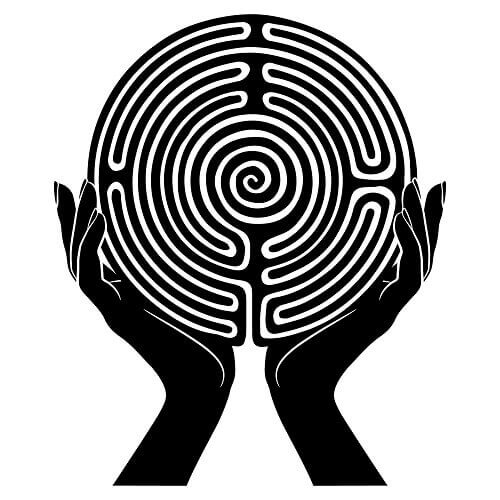
What is the sacred spiral?
The sacred spiral is a geometric symbol that represents a sacred and unbroken link between the macrocosm and the microcosm. The spiral is a bridge between the harmony in the cosmos and the harmony in us — an infinite resonance or life energy.
See also: Meaning of Sacred Circles
How old is the spiral symbol?
One of the oldest spiral symbols carved in stone (petroglyph) is found in the Newgrange entrance stone, dated to around 3200 BC. It is a prehistoric monument in County Meath in Ireland, built duing the Neolithic Period, making it older than the Egyptian pyramids and Stonehenge. The area has been a center of human settlement for at least 6,000 years, but the major structures date to around 5,000 years ago.
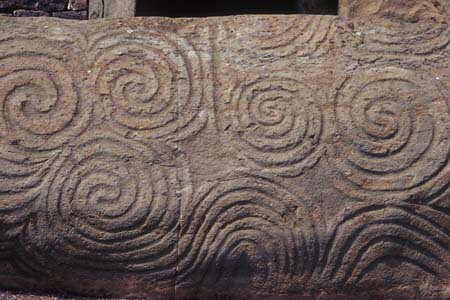
Other ancient spiral rock carvings are from the Early Bronze Age, 3000 – 2300 BC, and were found in the island of Naxos in Greece.
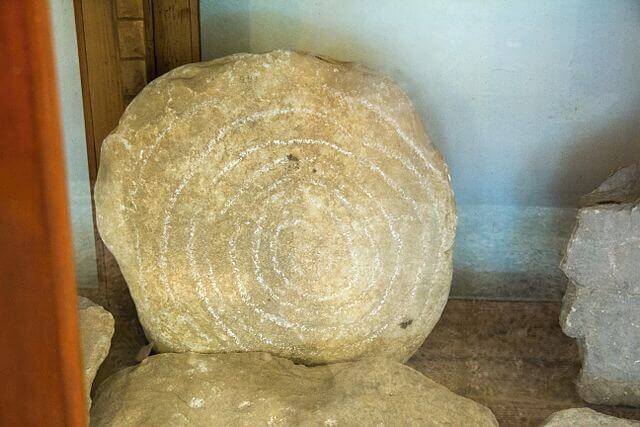
What does the symbol with 3 spirals mean?
The Great Triple Spiral, known as An Thríbhís Mhòr represents the three realms of the Gaelic universe: land, sea, and sky. The symbol with three spirals is also named Triskele or Triskelion and many of these Celtic spirals have survived carved in rock and can be found in Ireland, the British Isles and Galicia. The old Irish tale Táin Bó Cuailnge explains the perception of the world that the ancient Celts had, as being three separate realms: “Is it the sky that breaks or the sea that ebbs or the earth that quakes or is this the distress of my son fighting against odds on the Foray of Cuailnge?”
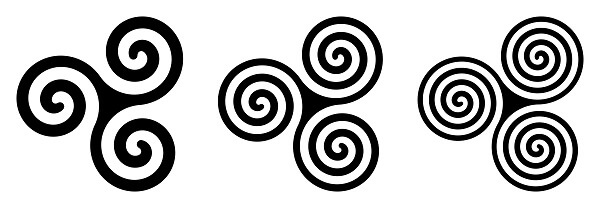
See also: Triquetra, the Spiritual Symbol of Triplicity
What does a spiral symbol mean in Native American culture?
In the Southwestern area of the United States, where the Anasazi people lived spiral shapes have been found in painting designs and pottery. Some of these spirals were used in combination with lizards and snakes. Often, the Native American spiral symbol is associated with the sun, however, for example, the Hopi pottery symbols and other rock art shows a single spiral as a symbol of the Ho-bo-bo, the twister or tornado.
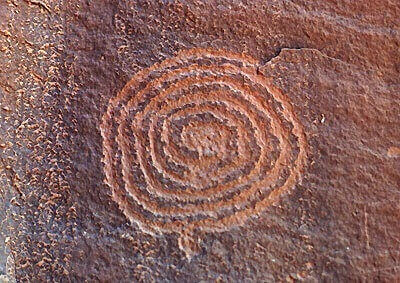
While many spirals have been used as a generic “tribal symbol”, their meaning can vary depending on which tribe it is inspired from. The Maya people of Mesoamerica used the spiral to represent the endless cycle and movement of life energy, Hunab Ku.
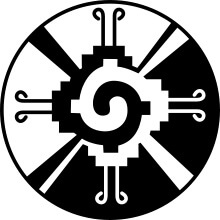
Spiral Direction Meaning
Many Anasazi spirals are counterclockwise which is a symbol of human activity, as opposed to the “sun-wise” direction said to duplicate the sun’s motion across the sky. However, the same spiral can be clockwise or counterclockwise depending on whether you trace it from the outside or the center.
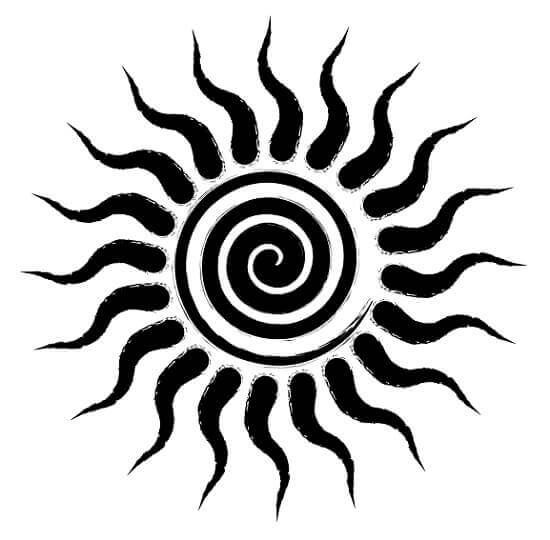
What is the spiral of life?
According to Anthropologist José Luis Cardero, “The Celts, the Mycenaeans and the ancient peoples used spirals to represent the concept of the Great Cosmic River of the Universe”. The spiral is the basic configuration of the chakras (wheels or vortexes of subtle energy) in the body and symbolize a change in scale, or even a portal to another dimension. Spiritually, the spiral of life is a symbol of the path to be traveled in life. This symbol is one of the first representations that have been found in Paleolithic caves and is constantly repeated throughout the planet.
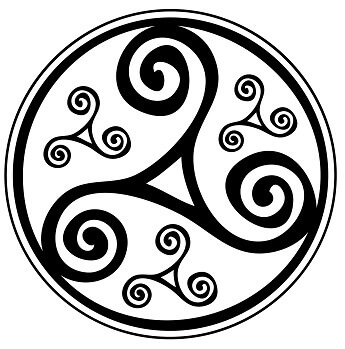
Spiral Goddess Meaning
The Spiral Goddess symbol is inspired by the ancient female figurines found in archaeological sites and is currently used as the main icon of the Goddess movement and other nature-based religions.
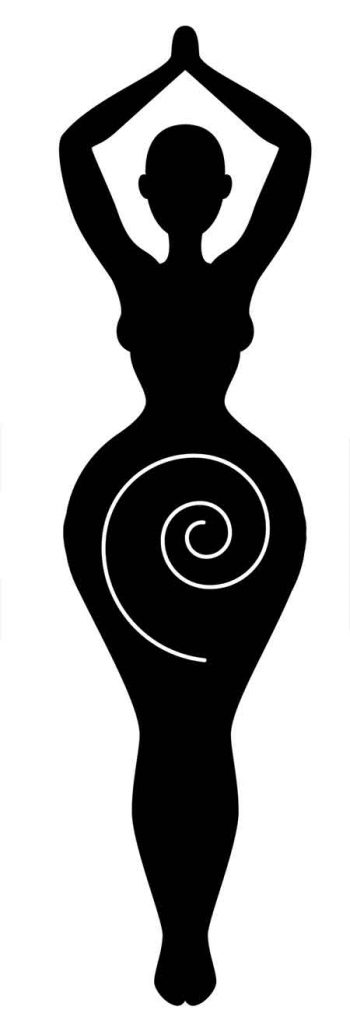
Since ancient times, sacred spirals were found embedded in architecture and artwork. There are many theories of the spiral or swirl symbol meaning, including the cycles of life and death, or as a symbol of the Mother Goddess or Divine Feminine.
THIS IS ALL PAGAN TEACHING. LIES STRAIGHT OUT OF THE PIT OF HELL. There is NO MOTHER NATURE. Goddess worship is the worship of the CREATION rather than the CREATOR. It is perversion. There is no circle of life. We are created to live once, there is no reincarnation. DEATH is final. Upon our death we are disposed either to ever lasting life with the father, or to everlasting torment with the DEVIL.
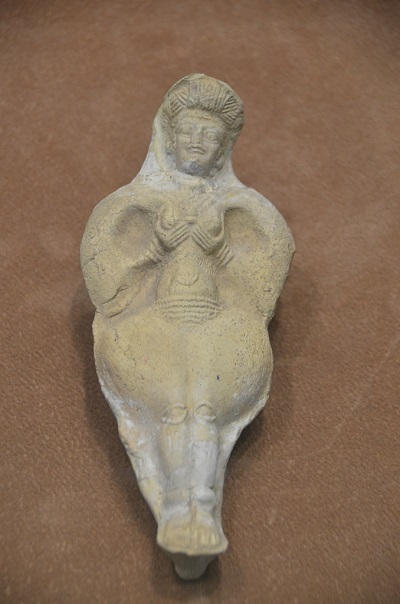
Sometimes the spiral goddess symbol is depicted alongside the crescent moons of the Triple Goddess Symbol, representing the cycles of life and the three aspects of the Goddess: Maiden, Mother and Crone.
In this case, the spiral Goddess symbol represents the womb, showing the energetic vortex through which we enter life. The spiral located in the belly of the Goddess also symbolizes how everything is born in curved shapes. There are no straight lines in Nature. The spiral is the symbol of life, creation, nature, strength and energy.
The fall in the Garden is what brought about the trap we find ourselves in. Life was perverted, and we were forced into this world where sin rules and DEATH exists. We were never meant to die. DEATH is the ultimate end of ALL SIN.
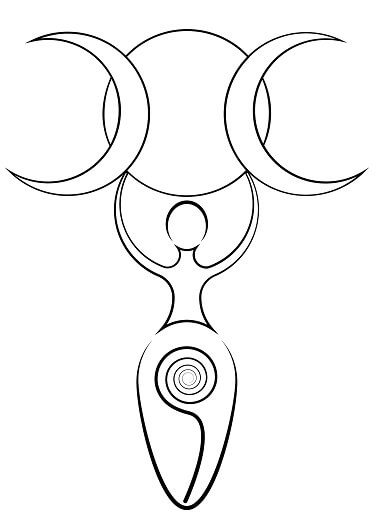
Her raised arms signify that the Goddess invokes the power of the spiral within her to bring life. The Goddess is the origin of everything, she is the beginning but also the end, She is the one who gave birth to the universe and the one who can destroy everything for its regeneration.
Boy, that paragraph ought to show you that this is the absolute opposite of the TRUTH. The Heavenly FATHER, is the creator of ALL THINGS and the GIVER OF LIFE. He is the ALPHA and OMEGA, the beginning and the end. One thing that got right is that the “goddess” represents the DESTROYER.
A spiral has also been referenced as a marker for transformation and, within Wicca and other faiths, it can be linked to the endless turns of the Wheel of the Year.
Spirals Are Everywhere
A sacred spiral represents unbound energy, and the cycles in which energy flows and manifests. Creation may appear to have a point of beginning, the between, and the end, but this is just part of the spiral of existence. That is a flat out lie!! Creation has a beginning and an end. The END is very near. BEWARE!! Spirals may represent the appearance of time and the different cycles we experience. We experience cycles, or seasons, in nature, astrology, history—and within our everyday lives. This points to there being an undercurrent of energy that penetrates through everything, promoting flow and change, in order to keep expansion and experience possible.
The moon and its cycles are an example of a sacred spiral—without it actually containing a spiral. There seems to be a beginning, the new moon, and an end, the full moon. These beginning and ends are subjective and hold no truth—because the moon is in a constant sate of flow and transformation. The earth’s weather spirals through seasons which we use to mark time. In ancient times this sacred spiral was honored and used to understand planetary patterns and changes in the weather.
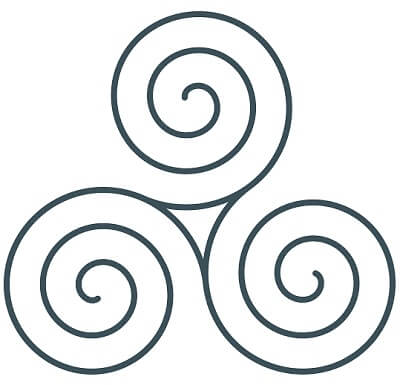
Spirals and Spirituality
In your spiritual practice you can harness the energy of the sacred spiral and tap into the infinite awareness and understanding of the universe. The spiral symbolizes the steady flow that exists within everything. When you are connected to your source self and your spiritual self, you are in a state of being that allows energy to freely move in and out of your experience. When you are allowing, life brings with it wonderful experiences. What a crock. You must see that they are talking about SELF as if you have the power to create your own world. BS. You are a slave to the sin nature. Nothing good can come out of that. The ONLY one who can set you free from sin and death is CHRIST JESUS. Yahushua the Messiah!
JAPAN GETS FIRST CREDIT
The sacred spiral indicates that we as human, and the world around us are connected in unimaginable ways. Even if we can’t understand the complexity of creation, we can see the universe’s signature of the spiral everywhere we look. Energy will always exist, whether it’s physical or non physical, and it will change and transform through never ending cycles of cosmic intelligence. We can use this understanding to allow our lives to unfold and for our lives to change, without resistance, as we allow the universe to dance through us, spinning and spiraling through everyone and everything.
THEY WANT YOU TO BE CONNECTED TO THE FORCES AND SPIRITS of the WORLD. The progeny of the fallen angels. They want you to give them access. If you do, only evil can be the result for they have no good in them.
spacer
AUGUST 2024 RARE NOVA IN THE SKIES
spacer
‘The Blaze’ star system exploded — how can you watch?
spacer
NASA, Global Astronomers Await Rare Nova Explosion
No, nova in Spanish does not mean “no go”. In fact, nova has the same meaning in Spanish as it does in English, which is “a big, bright star” or “Latin for ‘new'”. The phrase “no va” is pronounced differently and has a different meaning, which is “doesn’t go”. The stress is on the second syllable of “no va”, while the stress is on the first syllable of “nova”
No, the meme stood the test of time, or like the old Timex meme, It took a licking and keeps on ticking…
Even the “author” of the article discredits his own article when he admits that the Nova did not sell well and that the GM executives were baffled until someone finally pointed out to them that “nova” translates as “doesn’t go” in Spanish. The embarrassed automobile giant changed the model name to the Caribe, and sales of the car took off.
Let me repeat that, “the sales took off…”
I have no idea where the idea of “nova” means “doesn’t go” in Spanish, it does not… Perhaps some junior executive who took Spanish 101 in high school started this and perhaps that stuck…
In Spanish, “nova” means “nova” as in the astronomical event like when a star explodes…
However, when “nova” is spoken it is the same as when you say, “no va” and in Spanish that does mean “no go…”
I do not know why the sales were poor but perhaps it was the constant teasing the owners, or the comedians had a laugh over, perhaps it was just poor advertising on the part of GM… and by happen stance, the name change also included a much better ad campaign…
If you were going to buy a car and the name brought up thoughts of the power of an Exploding Star, or the vision of a car stuck on the side of the road; would you be inspired to buy a “no va?” Not I, or as they say in Spanish, “Yo no…”
spacer
- Astronomy: A nova is a star that suddenly increases in brightness and releases energy, often becoming the brightest object in the sky after the sun and moon. The word comes from the Latin word novus, which means “new”. In the past, people thought novas were new stars, but telescopes have since shown that they are actually old stars nearing the end of their lives.
- Girl’s name: The name Nova is of Latin origin and has been used since the 19th century. It’s especially popular in Scandinavian countries, and has also become more popular in recent years in European countries and the United Kingdom. Variations of the name include Novalee, Novalynn, and Novarae. Notable people with the name Nova include Aboriginal Australian Olympian Nova Maree Peris, English actress Nova Pilbeam, and American author Nova Ren Suma.
nova (n.)
s[acer
Corona Borealis, the Northern Crown, in July

On July and August evenings, look for the constellation Corona Borealis, also known as the Northern Crown. However, you’ll need a dark sky to see it. If you have one, the constellation is easy and distinctive. In fact, it makes the shape of the letter C. Then, in the middle of the C is a white jewel of a star. This star, the brightest light in the Northern Crown, is called Alphecca or Gemma.
To see this famous C-shaped pattern of stars from the Northern Hemisphere, you’ll be looking high overhead during the evening hours in July and August. From the Southern Hemisphere, the constellation is low in the northern sky.
The Crown is located roughly along a line between two bright stars. The first is the orange star Arcturus in the constellation Boötes the Herdsman. The second is beautiful, blue-white Vega in the constellation Lyra the Harp.
| Arcturus |
| Bootes |
| Vega (n.) |
| lyric (n.) |
Arcturus has already passed its highest point in the evening at this time of year and is slowly descending to the west. However, Vega is still high in the east in July and overhead in August evenings. With dark skies you’ll notice the orange color of Arcturus and Vega’s bright blue-white tinge.
Corona Borealis is between these two stars, though closer to Vega. Remember, a dark sky is best for seeing this faint semicircle of stars.

Or find it between two constellations
Also, you can look for the Northern Crown between the constellations of Hercules the Strongman and Boötes the Herdsman. See chart below.

Gem of the Northern Crown
The brightest star in Corona Borealis is Gemma at magnitude 2.21. The meaning of this Latin star name should be obvious. This star is the gem of the Northern Crown. It is 75 light-years distant.
But, as is the case with many stars, this star has more than one name. It’s also called Alphecca. This second name is from an Arabic phrase meaning the bright one of the dish. So you can see that, throughout history, stargazers have identified Corona Borealis with a common shape: a bowl, a disk, or a crown.
By the way, Gemma, aka Alphecca, is an eclipsing binary system. It consists of a smaller sunlike star that passes in front of a brighter star every 17.4 days, as seen from our earthly vantage point.
Read more about Gemma, aka Alphecca, in the Northern Crown
Other bright stars in the Northern Crown
The second brightest star, Beta Coronae Borealis, has the name of Nusakan. Nusakan shines at magnitude 3.65. Nukasan and Alphecca are a little less than three degrees apart. Nukasan lies 114 light-years away.
| NUSAKAN (Beta Coronae Borealis). The name of the second brightest star in Corona Borealis, the Northern Crown, has nothing whatever to do with the Crown itself, but refers to two “lines” of stars that outline a huge Arabic constellation called “The Pasture,” which incorporates much of Hercules and Ophiuchus. |
The other stars that make up the curved shape of Corona Borealis are all 3rd and 4th magnitude. Theta lies on the other side of Nukasan and Gamma and Delta lie on the other side of Alphecca. Also, Gamma is a double star, but the two are very close and require high magnification and steady skies to see.
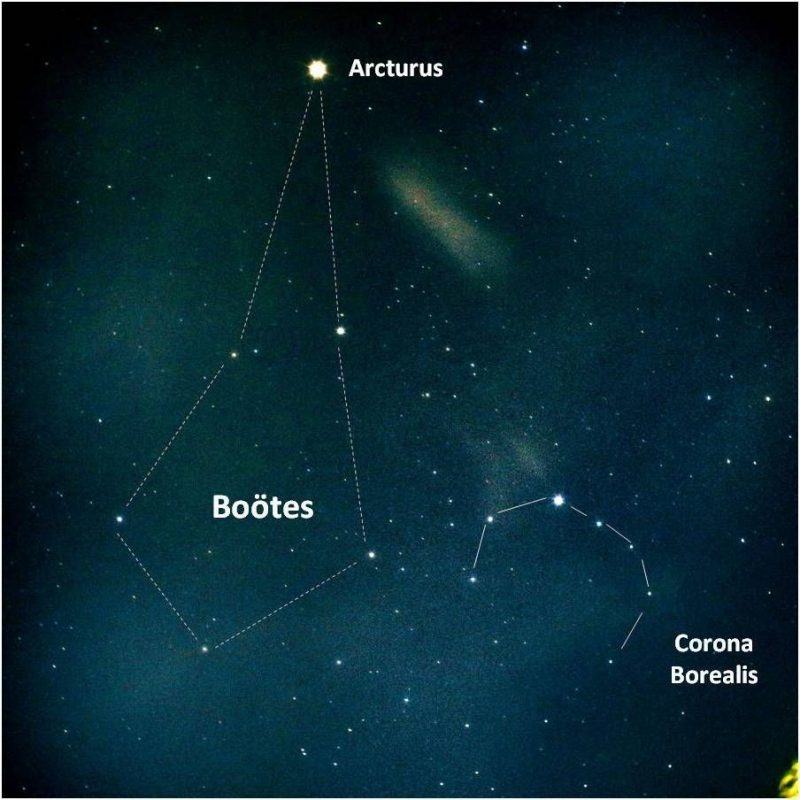
Bottom line: On July and August evenings, look for Corona Borealis’ graceful semicircle of stars between the two bright stars Arcturus and Vega.
EarthSky astronomy kits are perfect for beginners. Order yours
spacer
Corona Borealis is a small but recognizable constellation in the northern sky. Its name means “the northern crown” in Latin.
The constellation has only four stars brighter than magnitude 3.00. It was first catalogued by the Greek astronomer Ptolemy in the 2nd century. At the time, it was known simply as Corona. The Greeks saw the constellation representing the southern crown, Corona Australis, as a wreath.
Corona Borealis lies between the constellations Boötes and Hercules and represents the crown of Ariadne, daughter of King Minos in Greek mythology, who helped the hero Theseus defeat the Minotaur and find his way out of the labyrinth in which the creature lived. In Celtic mythology, Corona Borealis is known as Caer Arianrhod, or the Castle of Arianrhod, the place where the mythical Lady Arianrhod lived.
|
|
| ARIADNE was the immortal wife of the wine-god Dionysos.
There were several versions of her story. In one, Ariadne, a daughter of King Minos of Krete (Crete), assisted Theseus in his quest to slay the Minotauros (Minotaur) and then fled with the hero aboard his ship. When they landed on the island of Naxos Theseus abandoned her as she slept. It was then that Dionysos discovered her and made her his wife. Some say she was later slain by the goddess Artemis or else ascended to Olympos with her husband as an immortal. According to others Ariadne’s bridal with Dionysos occurred several generations before this when the god was still travelling the earth spreading his cult. During his war against Argives with a band of sea-women, Ariadne was slain or turned to stone by King Perseus. The god descended into the underworld to recover her and brought her back with him to Olympos. In Greek vase painting Ariadne is often depicted alongside Dionysos–either feasting with the gods of Olympos or in Bacchic scenes surrounded by dancing Satyroi (Satyrs) and Mainades. Dionysos’ discovery of the sleeping Ariadne on Naxos was also a popular scene in classical art. |
|
Ariadne Meaning |
Corona Borealis contains the famous Blaze Star (T Coronae Borealis), a recurrent nova, and the Fade-Out Star (R Coronae Borealis), but does not have any bright deep sky objects. The Corona Borealis Galaxy Cluster (Abell 2065) does not contain any galaxies brighter than 16th magnitude.
Facts, location and map
Corona Borealis is the 73rd constellation in size, occupying an area of 179 square degrees. It lies in the third quadrant of the northern hemisphere (NQ3) and can be seen at latitudes between +90° and -50°. The neighboring constellations are Boötes, Hercules, and Serpens Caput.
The constellation name Corona Borealis is pronounced /koʊˈroʊnə ˌbɔːriˈælɪs, -ˈeɪlɪs/. In English, the constellation is known as the Northern Crown. The genitive form of Corona Borealis, used in star names, is Coronae Borealis (pronunciation: /koʊˈroʊniː bɔːriˈælɪs/). The three-letter abbreviation, adopted by the International Astronomical Union (IAU) in 1922, is CrB.
Corona Borealis belongs to the Ursa Major family of constellations, along with Coma Berenices, Boötes, Camelopardalis, Canes Venatici, Draco, Leo Minor, Lynx, Ursa Major and Ursa Minor.
Corona Borealis has four stars with known planets and contains no Messier objects. The brightest star in the constellation is Alphecca (or Gemma, Alpha Coronae Borealis). There are no meteor showers associated with the constellation.

Corona Borealis constellation map by IAU and Sky&Telescope magazine.
Myth
Corona Borealis is associated with the myth of Princess Ariadne of Crete, most famous for her part in helping the Greek hero Theseus defeat the Minotaur, the creature with a human body and head of a bull that lived in a labyrinth designed by Daedalus. In the myth, Ariadne married the god Dionysus. The circlet of stars in the constellation Corona Borealis represents the crown made by the god Hephaestus that she wore on her wedding day.
The Minotaur was in fact Ariadne’s half-brother: according to the legend, her mother Pasiphae gave birth to the creature after copulating with one of King Minos’ bulls. The king had the Minotaur locked inside the labyrinth to hide the family secret. The labyrinth was designed in such a way that no one, not even the Minotaur, could find a way out.

In Greek mythology, the labyrinth was an intricate maze that was said to have been created by a skilled craftsman named Daedalus. The labyrinth is most famously known as the home of the Minotaur, a creature that was half-human and half-bull, and who terrorized the people of Crete. The story of the labyrinth begins with King Minos of Crete, who had angered the god Poseidon by failing to sacrifice a beautiful bull that the god had sent him. In revenge, Poseidon caused Minos’s wife, Queen Pasiphae, to fall in love with the bull, and from their union was born the monstrous Minotaur. King Minos was ashamed of his son, and so he asked Daedalus to construct a labyrinth to contain the creature. Daedalus was a brilliant inventor and architect, and he designed a maze so complex that even he himself could barely navigate it. The labyrinth was constructed with high walls and twisting passages, and it was said to be impossible to escape once you entered it. The Minotaur was placed at the heart of the maze, and every year, King Minos would send seven young men and seven young women from Athens as a tribute to the beast.
The legend of Theseus and the Minotaur Theseus, a brave Athenian hero, decided to put an end to this gruesome practice. He volunteered to be one of the tributes and journeyed to Crete. There, he met Princess Ariadne, who fell in love with him and gave him a ball of thread to help him navigate the labyrinth Theseus followed the thread to the heart of the maze, where he encountered the Minotaur. After a fierce battle, Theseus was able to slay the beast and find his way back out of the labyrinth, thanks to the thread provided by Princess Ariadne. The story of the labyrinth and the Minotaur has been told and retold throughout the centuries, and it continues to captivate and intrigue people to this day. The labyrinth has become a symbol of mystery and danger, and it has been featured in countless works of literature, art, and film. Daedalus: The Mastermind Behind the LabyrinthBut what about Daedalus, the creator of the labyrinth? Who was he, and what was his role in Greek mythology?
Daedalus was a skilled craftsman and inventor who was said to have been born in Athens. He was known for his intricate statues, his skill at making weapons, and his ability to construct elaborate machines. In addition to the labyrinth, Daedalus is also credited with the invention of wings, which he made for himself and his son, Icarus. Daedalus and Icarus were imprisoned on the island of Crete by King Minos, but Daedalus was able to fashion wings out of feathers and wax so that they could escape. However, Icarus flew too close to the sun, causing the wax on his wings to melt, and he fell to his death in the sea. Daedalus was grief-stricken by the loss of his son, and he continued to wander the world, creating art and inventions wherever he went. The story of Daedalus and the labyrinth is a cautionary tale about the dangers of pride and ambition. King Minos’s desire to contain the Minotaur and preserve his own reputation led to the creation of a deadly maze that claimed many lives. Daedalus, too, was undone by his own pride and ambition, as his desire to escape from Crete with his son led to his downfall. But even in his grief, he continued to create and innovate, leaving behind a legacy that has endured for centuries. Myths and Facts about The Labyrinth
|
|
also from c. 1400
|
When Theseus came to Crete, he was chosen to be one of the people put into the labyrinth for the Minotaur to find and eat. Ariadne fell in love with Theseus and, following Daedalus’ advice, gave him a ball of thread to take with him into the labyrinth if he promised to take her with him once he escaped. Theseus agreed. Once he defeated the Minotaur with his bare hands, the hero followed the trail of the thread and found his way out of the labyrinth.
Ariadne and Theseus sailed off together shortly thereafter, but he soon abandoned her on the island of Naxos. The god Dionysus found the princess weeping, fell in love, and the two were soon married. Ariadne wore a crown made by Hephaestus at the wedding and, once the ceremony was over, she tossed it into the sky, where the jewels turned into stars and the crown became the constellation Corona Borealis. The brightest star in the constellation, Gemma, got its name from the Latin word for “jewel.”
The Arabs know the constellation as “the poor people’s bowl” or Alphecca, which means “broken up.” The name Alphecca was later given to the constellation’s brightest star, Alpha Coronae Borealis.
The Cheyenne called the constellation the Camp Circle because its shape was similar to the way they arranged their camps, in a semi-circle.
.

Corona Borealis galaxy cluster (Abell 2065), image: Adam Block/Mount Lemmon SkyCenter/University of Arizona (CC BY-SA 4.0)
spacer
Explore the etymology and symbolism of the constellations
the Northern Crown

Urania’s Mirror1825
3. History_of_the_constellation
Clues to the meaning of this celestial feature
Corona Borealis, the Northern Crown, represents a crown given by Dionysus (Roman Bacchus, or Liber) to Ariadne, the daughter of Minos of Crete, who presented her with this Golden Crown inlaid with precious stones. It contains nine principal Stars, arranged in a semicircular form. [There is another crown in the heavens depicted in Corona Australis, the Southern Crown, it represents the crown given by Dionysus to his mother Semele].
 The story relating to Corona Borealis tells how Daedalus built a labyrinth, an elaborate maze-like construction, to house the Minotaur, a creature that was half man and half bull. Here it devoured the seven youths and seven maidens which were sent to it from Athens in tribute to king Minos of Crete who had conquered Athens. The tribute for the Minotaur was to be chosen by lot (sortis). When the third repetition of the nine-year tribute came around, Theseus inserted himself as one of the youths in the line-up. He got from Ariadne, daughter of Minos, who had fallen in love with him, the famous thread that enabled him to retrace his steps back through the Labyrinth. He slew the Minotaur, then, following the string or thread, he left the maze, unchained the young Athenians, and taking Ariadne whom he had promised to marry, along with him, they sailed off from Crete to Naxos. There Theseus deserted her as she lay sleeping. Ariadne was essentially marooned on an island, a castaway, while Theseus in his ship sailed off without her. Then Dionysus (Bacchus, Liber) came to her:
The story relating to Corona Borealis tells how Daedalus built a labyrinth, an elaborate maze-like construction, to house the Minotaur, a creature that was half man and half bull. Here it devoured the seven youths and seven maidens which were sent to it from Athens in tribute to king Minos of Crete who had conquered Athens. The tribute for the Minotaur was to be chosen by lot (sortis). When the third repetition of the nine-year tribute came around, Theseus inserted himself as one of the youths in the line-up. He got from Ariadne, daughter of Minos, who had fallen in love with him, the famous thread that enabled him to retrace his steps back through the Labyrinth. He slew the Minotaur, then, following the string or thread, he left the maze, unchained the young Athenians, and taking Ariadne whom he had promised to marry, along with him, they sailed off from Crete to Naxos. There Theseus deserted her as she lay sleeping. Ariadne was essentially marooned on an island, a castaway, while Theseus in his ship sailed off without her. Then Dionysus (Bacchus, Liber) came to her:
“Deserted and weeping bitterly, as she was, Bacchus-Liber brought her help and comfort. So that she might shine among the eternal stars, he took the crown from her forehead, and set it in the sky. It soared through the rarified air, and as it soared its jewels changed to bright fires, and took their place, retaining the appearance of a crown, as the Corona Borealis, between the kneeling Hercules and the head of the serpent (Serpens) that Ophiuchus holds” [Ovid, Metamorphoses, Bk VIII:152-182].
Ariadne as the consort of Dionysos, late fourth century BCE, (Louvre). [
 The myth of the Labyrinth can be read on this Theoi Project webpage. The myth of Ariadne on this Theoi Project webpage
The myth of the Labyrinth can be read on this Theoi Project webpage. The myth of Ariadne on this Theoi Project webpage
Manilius’ astrological influences for this constellation (see under astrological influences below) gives the cultivation of gardens, growing flowers, and arranging flowers into garlands (flores sertisque locabit, from Latin serta, garland). [Some see Greek anthos, flower, in the suffix –inth of labyrinth, labrys is Minoan for ‘double-axe’. Labyrinth is a term for the inner ear]
Latin serta, ‘wreathes of flowers, garlands’, which Klein says “is properly plural neuter past participle of serere, ‘to join together’.” The pattern of the myth of ‘deserted Ariadne‘ embraces a number of words from the Indo-European root *ser-. Latin serta, means a garland, from serere, to join. Crowns have a series of points, spikes (or they may be a turret shape). The tribute for the Minotaur was to be chosen by lot (sortilege, from sors, genitive sortis). These words come from the Indo-European root *ser- ‘To line up, lining up lots before drawing them’. Derivatives: series (cognate with Old Indian sarat, ‘thread’), assert, desert³ (abandon), dissertate, exert, exsert, insert, (these words from Latin serere, to arrange, attach, join – in speech, discuss), sermon, serried (in rows, from Latin sera, a lock, bolt, bar < ‘that which aligns’), assortment, sorcerer, sorcery, sort (means in this sense ‘destiny’ or ‘fortune’. Pronouncements from oracles were known as sortes in Latin, and sortes means ‘lots’ as in ‘casting lots’ or ‘drawing lots’), assort, consort, ensorcel (to enchant; bewitch), sortilege (the act or practice of foretelling the future by drawing lots). [Pokorny 4. ser– 911. Watkins] Klein and AHD adds desert (a barren desolate area).
“Our word disserit is used in a figurative meaning as well as in relation to the fields: for as the kitchen-gardener disserit ‘distributes’ the things of each kind upon his garden plots, so he who does the like in speaking is disertus ‘skilful.’ Sermo ‘conversation,’ I think, is from series ‘succession,’ whence serta ‘garlands’; and moreover in the case of a garment sartum ‘patched,’ because it is held together: for sermo ‘conversation’ cannot be where one man is alone, but where his speech is joined with another’s. So we are said consereremanum ‘to join hand-to-hand fight’ with an enemy; so to call for manumconsertum ‘a laying on of hands’ according to law; from this, adsereremanuinlibertatem’ to claim that so-and-so is free,’ when we lay hold of him. So the augurs say: If you authorize me to take in my hand the sacred bough, then name my colleagues (consortes). From this, moreover, sors ’lot,’ from which the consortes ‘colleagues’ themselves are named; from this, further, sortes ‘lots,’ because in them time-ideas are joined with men and things; from these, the sortilegi ‘lot-pickers, fortune-tellers’; from this, the money which is at interest is the sors ‘principal,’ because it joins one expense to another” [Varro: On The Latin Language, p.64, 66].
Ariadne, having married Dionysus, to be his consort. A consort crown is a crown worn by the Queen Consort of a kingdom for her coronation or on state occasions. Unlike with reigning monarchs, who may inherit one or more crowns for use, consorts sometimes had special crowns made uniquely for them and which were worn by no other later consort [].
Flora says: Bacchus [Dionysus] loves flowers. Bacchus’ pleasure in the wreath can be known from Ariadne’s star. Light theatre suits her. Do not, believe me, do not rank her with the tragic-booted goddesses [referring to the buskin boots worn by actors of Greek and Roman tragedies]. Indeed the reason why a crowd of whores packs these shows is not difficult to find. She is neither one of the glum set nor a snob; she wants her rites open to the plebs, and warns us to use life’s beauty as it blooms. [Ovid, Fasti 5.183
The Welsh knew the constellation, Corona Borealis, as CaerArianrhod, ‘castle of Arianhrod’, the prefix Arian– bearing a noted similarity to the name Ariadne. Caer ‘castle’ or ceaster, ‘castellated’ means turreted like a castle. Some crowns are described as turreted, Cybele wore a mural or turreted crown.
Romans poets associated the Minoan-Greek, Ariadne, with their goddess Libera []. Liber [Dionysos, or Bacchus] says to Ariadne:
“Let us seek heaven’s heights together. You have shared my bed and you will share my name. You will be named Libera, when transformed. I will create a monument of you and your crown, which Volcanus [Hephaistos] gave Venus [Aphrodite] and she gave you.’ He does what he said, and turns its nine gems to fires, and the golden crown glitters with nine stars.” – Ovid, Fasti 3.459 [
 The Statue of Liberty might relate to this constellation? Libera with a crown. The Statue of Liberty symbolically represents Libertas (liberty), Ancient Rome’s goddess of freedom from slavery, oppression and tyranny. Ariadne was marooned on an island. To be marooned is to be put ashore on a deserted island or coast and intentionally abandoned. A Maroon was the word for a fugitive slave in the West Indies in the 17th and 18th centuries. Liberia, a country in West Africa, was founded and settled mainly by freed slaves.
The Statue of Liberty might relate to this constellation? Libera with a crown. The Statue of Liberty symbolically represents Libertas (liberty), Ancient Rome’s goddess of freedom from slavery, oppression and tyranny. Ariadne was marooned on an island. To be marooned is to be put ashore on a deserted island or coast and intentionally abandoned. A Maroon was the word for a fugitive slave in the West Indies in the 17th and 18th centuries. Liberia, a country in West Africa, was founded and settled mainly by freed slaves.
The Statue of Liberty was a gift from France, but it is really a GREEK SYMBOL, A GREEK GODDESS.
The crown has associations with both liberty and also slavery “in ancient times slaves taken by right of conquest were sold wearing garlands, and hence were said to be sold ‘under a crown.’ For as the crown was a sign that those who were being sold were captives” [Aulus Gellius, (ca. 125 AD—after 180 AD), Noctes Atticae, Book 6]. The word ‘slave’ is related to the name of the adjacent constellation Hercules, who was a slave to Omphale for a year.
The crown given to Ariadne belonged to Venus: Allen (Star Names) says that when deserted by Theseus she became the wife of Liber Bacchus, and so took his name Libera; while the crown that Theseus — or, as some said, the goddess Venus — had given her was transferred to the sky:
“Victory herself is named from the fact that the overpowered vinciuntur ‘are bound.’ Poetry bears testimony to both, because both Victory and Venus are called heaven-born; for Tellus ‘Earth,’ because she was the first one bound to the Sky, is from that called Victory. Therefore she is connected with the corona ‘garland’ and the palma ‘palm’ [the customary symbols of victory] because the garland is a binder of the head and is itself, from vinctura’ binding,’ said vieri’ to be plaited,’ that is, vinciri ‘to be bound’; whence there is the line in Ennius’s Sota: The lustful pair were going, to plait the Love-god’s garland”. [Varro: On The Latin Language, p.59 ]
The astrological influences of the constellation given by Manilius:
“Corona the Crown’s lustrous ring, which twinkles with varying luminosity; for the circle is dominated by a single star [Alphecca], which with passing splendor sparkles in the mid forehead and enhances with its blazing flame the bright lights of the constellation. They shine as the memorial of deserted Ariadne” [Manilius, Astronomica, 1st century AD, book 5, p.29].
“Next to rise is Erigone [Virgo]. When you behold her ascending with five degrees wrested from the sea, there will emerge from the waves the bright memorial of what was once [in her lifetime] Ariadne’s crown; and gentle will be the skills herefrom bestowed. For here shines a maiden’s gifts. The child of the Crown will cultivate a garden budding with bright flowers and slopes. Grey with olive (trees) or green with grass. He will plant pale violets, purple hyacinths, lilies, poppies which vie with bright Tyrian dyes, and the rose which blooms with the redness of blood, and will stipple meadows with designs of natural color. Or he will entwine different flowers and arrange them in garlands; he will wreathe the constellation under which he was born, and like Ariadne’s crown will be the crowns he fashions; and stems he will squeeze together, and distil mixtures (make perfume) therefrom, and will flavor Arabian with Syrian scents and produce unguents which give off a mingled fragrance, that the charm of the perfume be enhanced by the blending. His heart is set upon elegance, fashion, and the art of adornment, upon gracious living and the pleasure of the hour. Such is the endowment prescribed by the years of the Maid and the flowers of the Crown” [Manilius, Astronomica, 1st century AD, book 5, p.321.]
© Anne Wright 2008.
| Fixed stars in Corona Borealis | |||||||
| Star | 1900 | 2000 | R A | Decl 1950 | Lat | Mag | Sp |
| Nusakan beta | 07SCO43 | 09SCO07 | 231 26 30 | +29 16 37 | +46 03 30 | 3.72 | A8 |
| theta | 08SCO04 | 09SCO27 | 232 43 40 | +31 31 36 | +48 33 24 | 4.17 | B5 |
| Alphecca alpha | 10SCO53 | 12SCO18 | 233 08 33 | +26 52 54 | +44 19 43 | 2.31 | A0 |
| gamma | 13SCO29 | 14SCO52 | 235 09 38 | +26 27 10 | +44 30 42 | 3.93 | A0 |
| delta | 15SCO39 | 17SCO02 | 236 52 26 | +26 13 12 | +44 46 14 | 4.73 | G4 |
| iota | 17SCO38 | 19SCO01 | 239 51 34 | +29 59 23 | +49 09 53 | 4.91 | A1 |
| epsilon | 17SCO44 | 19SCO07 | 238 52 44 | +27 01 17 | +46 04 30 | 4.22 | K2 |

Hevelius,Firmamentum, 1690
History of the constellation
from Star Names, 1889, Richard H. Allen
Looke! how the crowne which Ariadne wore
Upon her yvory forehead, . . .
Being now placed in the firmament,
Through the bright heavens doth her beams display,
And is unto the starres an ornament,
Which round about her move in order excellent.
— Spenser’s FaerieQueen
Corona Borealis, the Northern Crown {Page 174} is the French CouronneBoreale, the German NordlicheKrone, and the Italian ancestral Corona. It was the only stellar crown known to Eratosthenes and the early Greeks, but they called it Stephanos, a Wreath; and their successors, who had begun to locate the Southern Crown (Corona Australis), added to this title of the original the distinguishing protos; and beta Borelos to show its priority and its northern position. The Latins adopted the Greek name and adjectives in Coronaborea, borealis, and septentrionalis; and further knew it as the Crown of Vulcan fashioned exauroetindicisgemmis; or of Amphitrite, probably from its proximity in the sky to the Dolphin (Delphinus) associated with that goddess. But generally it was AriadnaeaCorona, CoronaAriadnae, CoronaAriadnes, CressaCorona, CoronaGnosida, CoronaCretica and Gnossis, varied by MinoiaCorona and MinoiaVirgo found with Valerius Flaccus and Germanicus, and AriadnaeaSidus with Ovid; these classical designations referring to Ariadne, or to her father Minos, king of Crete, and to her birthplace in that island, at Gnosos, where Theseus married her. When deserted by him she became the wife of Liber Bacchus, and so took his name Libera; while the crown that Theseus — or, as some said, the goddess Venus — had given her was transferred to the sky, where it became our Corona; and, as early as the 3rd century B.C., Apollonius Rhodius wrote in his Argonauticae
Still her sign is seen in heaven,
And midst the glittering symbols of the sky
The starry crown of Ariadne glides.
Keats changed this in his Lamia to Ariadne’tiar; and others made it the CoiledHairofAriadne as companion to the Streaming Tresses of Berenice (Coma Berenices). Some authors, however, — Ovid among them in his Fasti— said that Ariadne herself became the constellation; and Mrs. Browning, in her Paraphrases from Nonnus of HowBacchuscomfortsAriadne
{Page 175} Or wilt thou choose
A still surpassing glory? — take it all —
A heavenly house, Kronion’s self for kin.
This legend of Ariadne and her Crown seems to have been first recorded by Pherecydes early in the 5th century before Christ.
Dante, referring to Ariadne’s descent, called these stars laFigliuoladiMinoi, the poet giving much prominence to her father (King Minos) who “was so renowned for justice as to be called the Favorite of the Gods, and after death made Supreme Judge in the Infernal Regions.”
In all ages Corona has been a favorite, popularly as well as in literature, and few of our stellar groups have had as many titles, although the English of the Middle Ages usually wrote its wearer’s name “Adrian” and “Adriane.”
Chaucer had this strange passage on the constellation:
And in the sygne of Taurus men may see
The stonys of hire coroune shyne clere;
but this seems unintelligible, unless from some confusion in the poet’s mind with the location of Koronis of the Hyades. These, however, lie in the heavens just opposite the Crown, and Skeat ingeniously suggests that Chaucer may have meant that when the Sun was in Taurus the Crown was specially noticeable in the midnight sky, as is exactly the case.
“England’s Arch Poet,” Edmund Spenser, wrote in the ShepheardKalendar of 1579:
And now the Sunne hath reared up his fierie footed teme,
Making his way between the Cuppe (Crater) and golden Diademe;
one of the early titles of Corona being DiademaCoeli
The WreathofFlowers, occasionally seen for it, is merely the early signification of the words Stephanos and Corona.
Oculus was another name of the constellation — a term common in poetry and post-Augustan prose for any celestial luminary; and Prudens [Aurelius Clemens Prudentius, the Latin Christian poet of our 4th century] called it Maera, the Shining One.
As the ardenscorona of the Georgics, Vergil included it with the Pleiades as a calendar sign. May translating the passage:
{Page 176} But if thou plow to sowe more solid graine,
A wheat or barley harvest to obtaine:
First let the morning Pleiades be set,
And Ariadne’s shining Coronet,
Ere thou commit thy seed to ground, and there
Dare trust the hope of all the following yeare.
Columella, in a similar connection, called it GnosiaArdorBacchi, and NaxiusArdor, from Naxos, where Ariadne had been deserted by Theseus; and specially designated its lucida as claraStella
Its stars were favored also by the astrologers, Manilius expressing this in:
Births influenced then shall raise fine Beds of Flowers,
And twine their creeping Jasmine round their Bowers;
The Lillies, Violets in Banks dispose,
The Purple Poppy, and the blushing Rose:
For Pleasure shades their rising Mounts shall yield,
And real Figures paint the gawdy Field;
Or they shall wreath their Flowers, their Sweets entwine,
To grace their Mistress, or to Crown their Wine.
Bayer said of it AzophiParma, by which he meant that Al Sufi called it a Shield; but the majority of Arabian astronomers rendered the classical title by AlIklilalShamaliyyah, which degenerated into Acliluschemali and Aclushemali, and appeared with Ulug Beg as plain Iklil
But in early Arabia there was a different figure here, AlFakkah, the Dish, which Ulug Beg’s translator gave as Phecca, and others as Alphaca, Alfecca, Alfacca, Foca, Alfeta, and Alfelta; while Riccioli said AlphenaSyrochaldaeis; and Schickard, Alphakhaco
Hyde quoted KasatalSalik, and KasatalMasakin, the Pauper’s Bowl; and the Persians had the same in their KasahDarwishan, the Dervish’s Platter, or KasahShekesteh, the Broken Platter, because the circle is incomplete. Bullialdus latinized some of these titles in his Discusparvusconfractus, evidently taken from Chrysococca’s Pinakin keklasmenon, a Small Broken Dish, which, however, should read Pinakion (A “pinax” or “pinakion”, meaning “tablet,” because of its flat shape.).
The AlfonsineTables have Malfelcarre, “of the Chaldaeans,” Riccioli’s Malphelcane, considered by Ideler a degenerate form of the Arabic AlMuniralFakkah, the Bright One of the Dish; though Buttmann derived it from AlMalfalKhatar, the Loop of the Wreath, or the Junction of the Crown; and Scaliger suggested AlMalifalKurra, of somewhat similar meaning, more correctly written AlMilaffalKurrah. Bayer said Malphelcarrequodestsertumpupillae, the Circle of the Pupil of the Eye; and, although he did not explain this, may have written better than he knew, {Page 177} for Pupilla is the Latin equivalent of Kore, which, as a proper name, was a title for Persephone. In La Lande’s Astronomic Dupuis (circe 1862) devoted much space to his identification of this goddess, the Latin Proserpina, with the Chaldaean Phersephon, taking the title from Phe’er, Crown, and Serphon, Northern. Thus, if Dupuis be correct, the origin of the figure, as well as of the name, may lie far back of Cretan days. The Hebrews are said to have called it ‘Ataroth, the Crown, — perhaps of the Semitic queen Cushiopeia; and the Syrians, Ashtaroth, their Astarte, the Aphrodite of the Greeks and the Venus of the Latins; but all this seems doubtful, as also is Ewald’s conjecture that it was the biblical Mazzaroth.
Blake quotes from Flammarion, Vichaca, but without explanation.
Reeves catalogued it as the Chinese KwanSoo, a Cord. In Celtic story Corona was CaerArianrod, the House of Arianrod or Ethlenn, the sister of Gwydyon and daughter of Don, the Fairy King, this name bearing a singular resemblance to that of the classical owner of the Crown.
The Shawnee Indians knew it as the CelestialSisters, the fairest of them being the wife of the hunter White Hawk, our Arcturus
Caesius said that it represented the CrownthatAhasuerusplaceduponEsther’head, or the goldenoneoftheAmmoniteKing of a talent’s weight, or the CrownofThorns worn by the Christ.
Tlie LeydenManuscript shows it as a laurel wreath, and thus, or as a typical crown, it appears on the maps. In the FirmamentumFirmianum, a work of 1731, in honor of the persecuting bishop of Salzburg, of the Firmian family, the figuring is that of the CoronaFirmiana, with a stag’s antlers from the coat of arms of that family. But an exception to the rule may be noted in an illustration, in the original AlfonsineTables, of a plain three-quarter circle, entirely unlike either crown or wreath. Proctor suggested that in the earliest astronomy it may have formed the right arm of Bootes
It is interesting to the astronomer from its many close binaries, and is a favorite object with youthful observers, who generally know it as Ariadne’Crown. It certainly is much more like that for which it is named than usually is the case with our sky figures; and it is equally suggestive to the Australian native of the Woomera, our Boomerang, his idea of Corona’s stars.
Here appeared very suddenly, 58′ south of epsilon, on the 12th of May, 1866, the celebrated BlazeStar as a 2d-magnitude visible to the naked eye for only eight days, declining, with some fluctuations, to the 10th magnitude at the rate of half a magnitude a day, but rising again to the 8th, where it {Page 178} still remains as T Coronae, a pale yellow, slightly variable star. Although called a nova, Argelander had already mapped it on the 18th of May, 1855, and again noted it on the 31st of March, 1856, probably at its normal magnitude. It was the first temporary star to be “studied by the universal chemical method” — the spectroscope.
Near its place the VariabilisCoronae, now lettered R, was discovered by Pigott in 1795, still varying from 5.8 to 13, but with much irregularity.
Professor Young repeats the bagdel of Cassiopeia as a help to the memory in locating the stars of this constellation. The extreme northern one is theta, but then follow in order beta, alpha, gamma, delta, epsilon, iota. They form an almost perfect semicircle 20° northeast of Arcturus
Argelander gives a total of 27 stars visible to the naked eye; and Heis, 31.
One plac’d i’ th’ front above the rest displays
A vigorous light, and darts surprising rays —
The Monument of the forsaken Maid.
— Creech’s Manilius
Star Names: Their Lore and Meaning, Richard H. Allen, 1889.]
spacer
AUGUST 2024 SUPERMOON
spacer
sturgeon (n.)
spacer

What is a whirling dervish and why is it called that
What is a whirling dervish and why is it called that ?
The Mevlevi Order or Mawlawiyya (Turkish: Mevlevilik or Mevleviyye; Persian: طریقت مولویه) is a Sufi order that originated in Konya and which was founded by the followers of Jalaluddin Muhammad Balkhi Rumi, a 13th-century Persian poet, Sufi mystic, and Islamic theologian. The Mevlevis are also known as the “whirling dervishes” due to their famous practice of whirling as a form of dhikr (remembrance of God). Dervish is a common term for an initiate of the Sufi path; whirling is part of the formal sema ceremony and the participants are properly known as semazens.
In 2008, UNESCO confirmed “The Mevlevi Sema Ceremony” as amongst the Masterpieces of the Oral and Intangible Heritage of Humanity.
Approximately 750 years old, the Mevlevi Order is a living tradition based on the teachings of Rumi, also known as Mevlana, who is perhaps Turkey’s most celebrated poet and in Iran, second only to Hafiz. He is also venerated as a divine mystic within Sufi Islam. Rumi’s friend and spiritual mentor, Shams of Tabriz, is also revered within the order and within Sufism more widely.
Rumi said, “As long as I have life, I am the slave of the Quran. I am dust at the door of Muhammad the Chosen”, and the Mevlevi path is based firmly on Islamic principles. Kabir Helminski, a Mevlevi shaikh, writes ‘It is a rigorous path of initiation and service continually adapting itself to changing circumstances and times…. Mevlevis have always been progressive and liberal in spirit while at the same time conserving the best of tradition.’
The Mevlevis insist that love is at the centre of Islam. Mevlevi shaikh Şefik Can writes, ‘Rumi tells us to take the love of God to the forefront, to abstain from being attached to the letter of the law rather than the spirit of it, to find the essence of the faith, and to raise our faith from the level of imitation to the level of realization.’
In addition to obligatory Islamic worship, some of the main spiritual practices within the Mevlevi Order are as follows:
Dhikr: invocation of the Divine Names which is believed to purify the heart
Sema (sama): the whirling ceremony
Study of the Quran and Rumi’s works (especially his poetic masterpiece the Mathnavi)
Spiritual conversation led by the shaikh (sohbet)
Meditation (known as muraqabah in Islam)
Adab (developing courtesy and mindfulness)
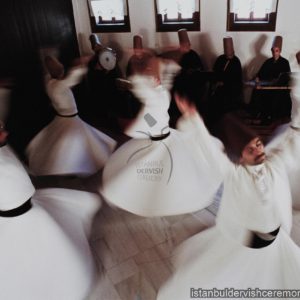 Whirling Dervish Ceremony in Sultanahmet
790.00₺
|
 Hocapasha Culture Center Whirling Dervish Ceremony
1,240.00₺
|
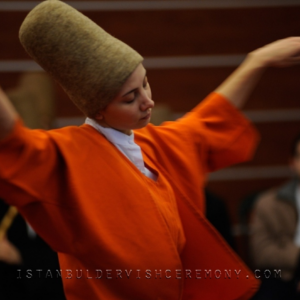 Whirling Dervish Ceremony Real Monastery in Fatih
1,350.00₺
|
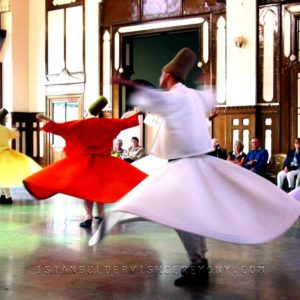 Whirling Dervish Ceremony in Sultanahmet Sirkeci Train Station
200.00₺
|
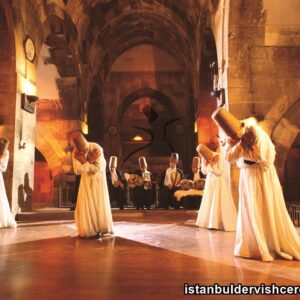 Whirling Dervish Ceremony in Saruhan Cappadocia
1,050.00₺
|
 Galata Mevlevi House Dervish Ceremony
|
-
 Tailor Made Whirling Dervish Dress Costume
Tailor Made Whirling Dervish Dress Costume
Sema/Sama
The Sema with the greatest significance to the Mevlevi order is the annual celebration of Mevlana’s marriage to god (death), also called Seb-i Arus, meaning Nuptial Night or Night of Union. It is observed for one week, with the final night occurring on the anniversary of his death. Pilgrims from all over the world travel to Konya for the official celebration. The event is so popular that a ticketing system is in place for those who wish to attend.
Rumi mentions whirling in a number of his poems. In one ghazal in the Divani Shamsi Tabriz he says:
Those who turn in the direction of prayer,
whirl in both this world and the next.
Pay heed when a circle of friends whirl,
circling round and round, the Kaaba is the center.
If you wish a mine of sugar, it is there;
and if you wish a fingertip of sugar, it is gratis.
According to a popular story, Rumi was first inspired to whirl when he heard the hammering of the goldsmiths in Konya’s bazaar, however, Mevlevi historian Abdülbâki Gölpınarlı believed that Rumi must have learnt whirling from Shams of Tabriz. Şefik Can claimed that whirling was practiced among Sufis at least as early as Abu Sa’id Abu’l-Khayr (d. 1049). Though they have cultivated it to the highest degree, Mevlevis are not the only Sufis who practice whirling, and Kabir Helminski suggests primordial origins: ‘The practice of whirling may have its origins in the timeless shadows of Central Asian spirituality where shamans used it to induce altered states of consciousness.’
Sema (or sama) is traditionally practised in a semahane (ritual hall) according to a precisely prescribed symbolic ritual with the semazens whirling in a circle around their shaikh. Semazens whirl using their right foot to propel themselves in a counter-clockwise circle, whilst their left foot remains rooted to the floor acting as an axis about which the semazen turns. Both arms are extended and raised to the level of the head, with the right palm pointing upward (believed to be receiving Divine grace) and the left palm pointing downward (believed to channel that grace to the world). With each 360° turn, the semazen is inwardly chanting “Allah” – a form of dhikr.
The semazens enter wearing a black cloak (hırka) symbolizing death and the grave, which they remove before whirling. On their heads they wear a tall, brown hat known as a sikke, which symbolizes the tombstone and the death of the ego (a version of the “Sikke” is also worn by the Bektashi). Once their cloaks are removed, their long white robes (tennûre) and white jackets (destegül – meaning ‘bouquet of roses’) become visible. Both are symbols of resurrection.
Structure of the ceremony
Naat-i Sharif – The naat marks the beginning of the ceremony in which a solo singer offers a eulogy to the Prophet Muhammad. It is concluded with a taksim (improvisation) on the reed flute (ney), which symbolises the Divine breath that gives life to everything.
Devr-i Veled – The Sultan Veled walk involves the semazens walking slowly and rhythmically to the peshrev music. After slapping the ground forcefully (representing the Divine act of creation when God said ‘Be!’ according to the Quran), they make a circuit in single file around the hall three times, bowing first to the semazen in front of them, and then to the semazen behind them as they begin each circuit. The bow is said to represent the acknowledgement of the Divine breath which has been breathed into all of us and is a salutation from soul to soul. The dervishes then remove their black cloaks.
The Four Salams – The Four Salams (Selams) form the main part of the ceremony and are distinct musical movements. According to Dr. Celalettin Celebi and Shaikh Kabir Helminski, ‘The first selam represents the human being’s birth to Truth through knowledge, and through his awareness and submission to God. The second selam represents the rapture of the human being while witnessing the splendour of creation and the omnipotence of God. The third selam is the transformation of rapture into love, the sacrifice of mind to love. It is annihilation of the self within the Loved One. It is complete submission. It is unity…. The fourth selam is the semazen’s coming to terms with his destiny. With the semazen’s whole self, with all his mind and heart, he is a servant of God, of God’s books and His prophets – of all Creation.’
Quranic recitation – The ceremony concludes with a recitation from the Quran, which normally includes the following verse: God is in the East and West. And wherever you turn, there is the face of God. (Quran 2:115)
History
The order was established after Rumi’s death in 1273 by his son Sultan Veled and Husameddin Chelebi (who inspired Rumi to write the Mathnavi). Like his father, Sultan Veled is celebrated for his poetry. Lyrics he wrote are often sung during the sema ceremony itself, and both he and Husameddin Chelebi are honoured within the order as accomplished Sufi mystics in their own right. It was they who had Rumi’s mausoleum built in Konya, which to this day is a place of pilgrimage for many Muslims (and non-Muslims). A number of Rumi’s successors, including both Sultan Veled and Husameddin Chelebi themselves, are also buried there. Their personal efforts to establish the order were continued by Sultan Veled’s son Ulu Arif Chelebi.
During the Ottoman period, the Mevlevi order spread into the Balkans, Syria, Lebanon, Egypt, and Palestine, especially in Jerusalem. The Bosnian writer Meša Selimović wrote the book The Dervish and Death about a Mevlevi dergah in Sarajevo. Eventually, there were as many as 114 Sufi lodges, the order becoming well established within the Ottoman Empire when Devlet Hatun, a descendant of Sultan Veled, married Bayezid I. Their son Mehmed I Çelebi became the next sultan, endowing the order, as did his successors, with many advantages. Many of the members of the order served in various official positions within the caliphate.
To this day, responsibility for overseeing the Mevlevi Order is passed down through the generations of Rumi’s male descendants. The head of the order is referred to as Çelebi (Chelebi) which means ‘man of God’ or ‘noble, courteous’ according to Mevlevi historian Abdülbâki Gölpınarlı. The current Çelebi is Faruk Hemdem Çelebi. He is also president of the International Mevlana Foundation (UluslararasI Mevlânâ Vakfi), a Turkish cultural and educational foundation managed by his sister and vice-president Esin Çelebi Bayru. Shaikhs, who have the authority to teach Mevlevi practices and philosophy, are appointed by the Çelebi.
Artistic heritage
Rumi’s Mathnavi and Diwan-e Shams-e Tabrizi are considered masterpieces of Persian literature, and throughout the centuries the Mevlevi Order has continued its long-standing association with the arts in Turkey. Apart from the works of Rumi and Sultan Veled, other famous literary works by Mevlevis include influential commentaries on Rumi’s Mathnavi by Ismāʿil Rusūhī Ankarawi (d. 1631) and Ismāʿil Ḥaqqı Burṣalı (d. 1724), the latter also being ‘a fine mystical poet’ in his own right. The most celebrated Mevlevi poet, after Rumi and Sultan Veled, is Shaykh Ghalib Dede (d. 1799), the author of Hüsn ü Aşk and ‘perhaps the last true master of Turkish classical poetry’ according to scholar Annemarie Schimmel. Both Ghālib Dede and Ankarawī are buried at the Galata Mevlevihanesi.
A significant number of the most celebrated Turkish musicians have been Mevlevis, and during the Ottoman era the Mevlevi Order produced a great deal of vocal and instrumental music. Mustafa Itri (1640–1712), an Ottoman-Turkish musician, composer, singer and poet, is regarded as the master of Turkish classical music. Ismail Dede (1778-1846) is also considered one of Turkey’s greatest classical composers and wrote the music for the ceremonial songs (ayins) played during the sema ceremony. Celebrated female musicians and composers include Dilhayat Khalifa (early 1700s) and Layla Saz (late 1800s – also buried at Galata Mevlevihanesi)
Women in the Mevlevi Order
Camille Helminski explains in her book, Women of Sufism, A Hidden Treasure, how Rumi had a number of noteworthy female students, and how in the early days of the order there were instances of female shaikhs and semazens, such as Destina Khatun (who was appointed shaykha of the Kara Hisar Mevlevi lodge). ‘In the early days of the Mevlevi order, women and men were known to pray, share sohbet (spiritual conversation), and whirl within each other’s company, though more often as the centuries unfolded, women held their own semas and men also whirled in zhikr separate from women. However, in the time of Mevlana [Rumi], spontaneous semas would occur including both men and women.’. In the same book, Camille Helminski presents a letter (dated from 1991) from Celaleddin Bakir Çelebi (who was the Çelebi heading the order at that time) which grants permission for men and women to once more whirl together in mixed Mevlevi ceremonies.
How can one participate?
You can make reservations from here ( online ), you can e-mail us or you can visit our ticket center in advanced and make your reservation in person. Here are our details ;
LOCATION of our Meeting Point in Sultanahmet :
https://goo.gl/maps/uXuyRmELZsx
Contact People : Mr. Alp – Mr. Nurdogan
( Phone : +90 544 220 10 22 / +90 212 527 68 59 )
Here is our address :
Google Maps : https://goo.gl/maps/uXuyRmELZsx
Istanbul Dervish Ceremony – Les Arts Turcs / Culture Center
Alemdar Mh. Incili Çavus St.
No: 19 Floor : 3 (Behind The Underground Cistern)
Sultanahmet 34400
Istanbul, Turkey
SAMA – Part 1 of 2 -The Pagan Influence on Society
SAMA – Part 2 of 2 – The Pagan Influence on Society
Do You Believe In Magick? Part 9 – Eastern Invasion Continued
EASTERN INVASION Continued Cynthia Pawl, January 30, 2016: RESTORED 4/25/22 Just a few of the reasons why yoga cannot be separated from its occultic origins are: (1) The mantra meditation lowers mental barriers and opens one up to the demonic realm (though it often doesn’t “feel” demonic at first…it feels “good” and “spiritual”…..even … Click Here to Read More
SPACER
Do You Believe In Magick? Part 8 – Easternization through Meditation
Easternization through MEDITATION Cynthia Pawl, January 30, 2016 / Updated 11/4/2020 Transcendental Meditation TM technique involves the use of a sound or mantra, and is practiced for 15–20 minutes twice per day. During which time one is to use the mantra to facilitate the “emptying of one’s mind” in preparation to receive. Transcendental Meditation movement … Click Here to Read More
spacer
Do You Believe in Magick? Part 7 – Easternization of the USA
EASTERNIZATION OF THE USA Originally posted by Cynthia Pawl, January 30, 2016; updated 7/2018 President’s YOGA PALA Challenge 2011 …. You can start now…. Since 2001, the popularity of yoga in the USA has risen constantly. This has been due to the fact that most large corporations, sports teams, and school systems have made the … Click Here to Read More
COMPLICIT IN OUR OWN DESTRUCTION!
COMPLICIT IN OUR OWN DESTRUCTION New Age Indoctrination via the Yoga Health Fad By Cynthia Pawl RESTORED: 5/14/22 HELLO OUT THERE!!! IS ANYBODY HOME?? Honestly, this is not a joke. I am very concerned for the minds, hearts and souls of people. Especially people here in the United States. Take a real long, serious look … Click Here to Read More
spacer
space
Mythologia – Wikipedia, le encyclopedia libere
Mythology [my-to-lo-gía] is a set of mythos , or legendary stories, of a people or religion , having a common origin or theme.
spacer
spacer


 Asclepius is one of the lesser-known gods of Greek mythology, but he still had a vitally important role to play.
Asclepius is one of the lesser-known gods of Greek mythology, but he still had a vitally important role to play.  Ares: The God of War
Ares: The God of War Historical Sites Connected to Mythology
Historical Sites Connected to Mythology Top Archaeological Sites in Paros
Top Archaeological Sites in Paros
 A nymph (
A nymph (










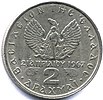























152 Comments